What wild animals do when the sun goes down
IN THIS ISSUE:

HONEY BEES AND RINGNECKS
MONTANA’S ROCKY MOUNTAIN BIKE HIGH THE LEGAL (AND YUMMY) WAY TO POACH FISH

What wild animals do when the sun goes down
IN THIS ISSUE:

HONEY BEES AND RINGNECKS
MONTANA’S ROCKY MOUNTAIN BIKE HIGH THE LEGAL (AND YUMMY) WAY TO POACH FISH
12 The Queen City’s Ride to the Top Mountain biking is booming across the West, especially in areas like Helena, designated one of America’s premier off-road cycling communities. By Peggy O’Neill

20 My Hidden Trout Treasure While hunting grouse in a remote Lincoln County forest, I came upon a beaver pond that looked like it might hold a few small fish. Was I ever surprised. By Ben Long. Illustration by Ed Jenne.
24 Ready for the Handoff Step by step, Montana lays the groundwork for resuming state management of grizzly bears. By Tom Dickson
30 When the Sun Goes Down Shining a light on the secretive nighttime habits of Montana wildlife. By Julie Lue
37 Godspeed, Little Ram Tracking an especially tough bighorn sheep. By Rebecca Mowry
38 Pollinators Forever Protecting flowering plants helps everything else on the prairie—from bees and butterflies to pheasants and other ground-nesting birds. By Andrew McKean
MONTANA OUTDOORS
VOLUME 54, NUMBER 4
STATE OF MONTANA
Greg Gianforte, Governor
MONTANA FISH, WILDLIFE & PARKS
Temple, Director MONTANA OUTDOORS STAFF Tom Dickson, Editor
Duran, Art Director
Howell, Circulation Manager
MONTANA FISH AND WILDLIFE COMMISSION
Robinson, Chair MONTANA STATE PARKS AND RECREATION BOARD
Montana Outdoors (ISSN 0027-0016) is published bimonthly by Montana Fish, Wildlife & Parks in partnership with our subscribers. Subscription rates are $15 for one year, $25 for two years, and $30 for three years. (Please add $3 per year for Canadian subscriptions. All other foreign subscriptions, airmail only, are $50 for one year.) Individual copies and back issues cost $5.50 each (includes postage). Although Montana Outdoors is copyrighted, permission to reprint articles is available by writing our office or phoning us at (406) 495-3257. All correspondence should be addressed to: Montana Outdoors, Montana Fish, Wildlife & Parks, 930 West Custer Avenue, P O. Box 200701, Helena, MT 59620-0701. Website: fwp.mt.gov/montana-outdoors. Email: montanaoutdoors@ mt.gov. ©2023, Montana Fish, Wildlife & Parks. All rights reserved. For address changes or subscription information call 800-678-6668 In Canada call 1+ 406-495-3257
Postmaster: Send address changes to Montana Outdoors, Montana Fish, Wildlife & Parks, P O. Box 200701, Helena, MT 59620-0701. Preferred periodicals postage paid at Helena, MT 59601, and additional mailing offices.
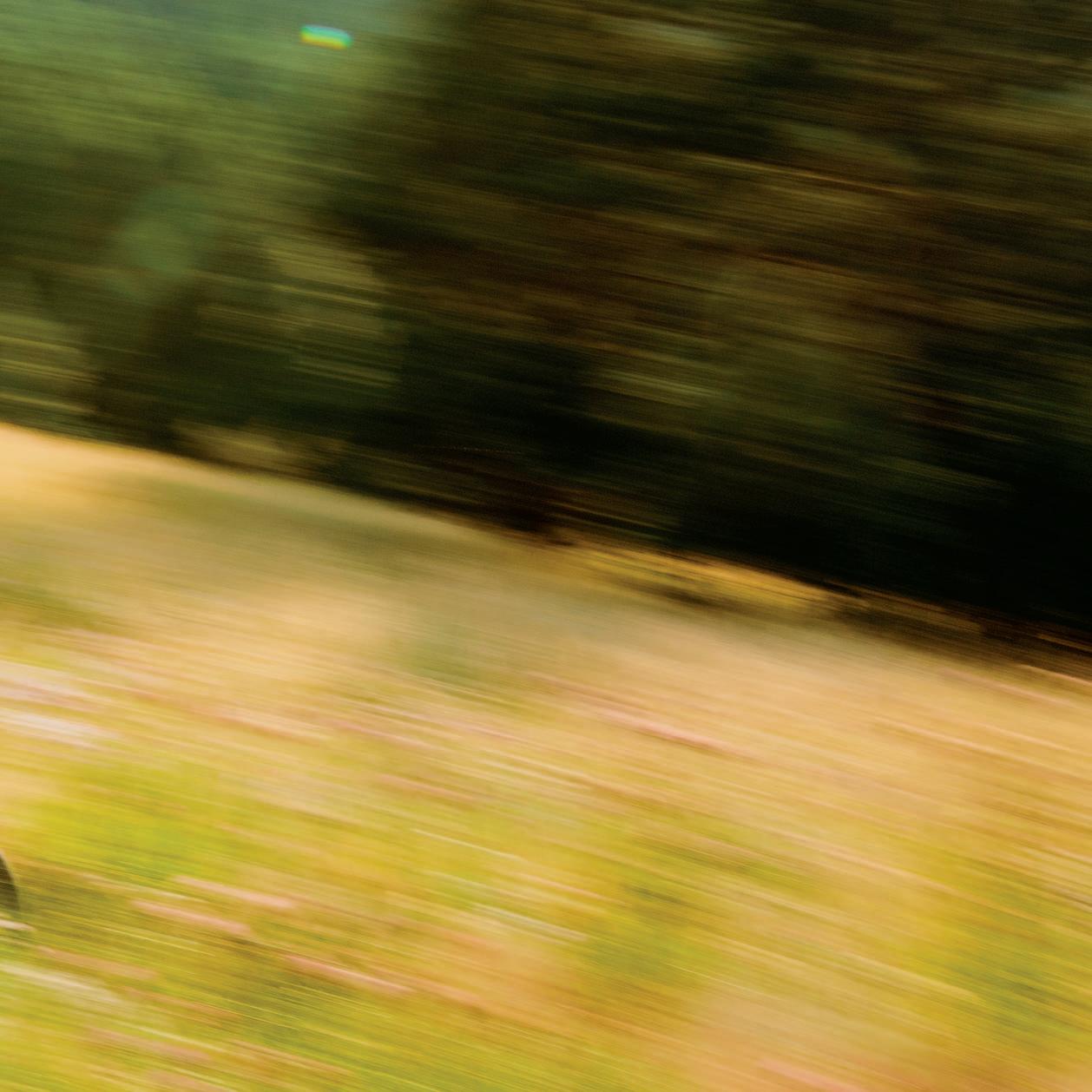 CLEAN RIDE Montana mountain bike–racing legend Emmett Purcell bombs a trail in Helena’s South Hills. Turn to page 12 to learn how the sport got started and why the Queen City rules when it comes to off-road trail access. Photo by Aaron Theisen.
CLEAN RIDE Montana mountain bike–racing legend Emmett Purcell bombs a trail in Helena’s South Hills. Turn to page 12 to learn how the sport got started and why the Queen City rules when it comes to off-road trail access. Photo by Aaron Theisen.
Sibling griz update
Editor’s note: Jamie Jonkel, FWP bear management specialist in Missoula, sent us this email he recently received, along with his response. We thought other readers also would be interested in an update on the grizzly bear siblings featured in our article “Together Again” (May-June 2023).
Hi, Jamie: We read the story about the sibling grizzly bears. We really liked the story, it was interesting, and we are excited to learn more about the bears’ story. We were wondering if you have any current information about the bears and where they are at now. Also, do you know of any apps that show their locations and progress?
Kylie Carroll
Mae Francisco
Laney Stillwagon
Ms. Eurling’s 5th Grade Class
Margaret Leary Elementary School Butte
Jamie Jonkel’s reply: Hi, Kylie, Mae, and Laney: The two grizzly siblings (we think they are siblings) emerged from their den on the Rocky Mountain Front, near Haystack Butte, in early April. The female, known as “Lichenstone,” dropped her collar in the den. But the male, “Kolb,” still has his collar. They were observed this spring together at the den site, and they looked fat and healthy. The male has since moved south and is near Ovando. We believe his sister is traveling with him, but that has not been verified. He appears to be heading south. Maybe they’re heading back to the Bitterroot Valley, where they spent several months last fall? We should know more as the summer progresses. I’m sorry to say that we do not have an app showing their location, but I am sending you this photo (above) of Lichenstone when we released her in the Sapphire Range last October.
Playing the name game
I enjoyed your article on fish and wildlife names (“What’s That Animal Called?” March-April 2023), which should be required reading for every beginning biologist. As a biologist myself, it has always been a challenge to accurately communicate with the public and other scientists different plant and animal names. As you point out, the use of DNA and other genetic methods has led to widespread re-naming. Sometimes only the scientific names are changed yet the common names remain intact, while other times both the scientific and common names change. When writing technical documents, it is essential to cite the source used when naming a plant or animal.
The use of hyphens is especially troublesome. Douglas-fir, for instance, is hyphenated by some organizations to indicate that the tree is not a true fir. Other plant names, such as thin-leaved alder, follow the same style conventions as applies to animals like white-tailed deer, or they lose their hyphen altogether and become a compound name such as sweetgrass. To confuse matters more, some plants and animals have the same generic name. The upland sandpiper and several mosses are of the genus Bartramia.
Then there is the social status of being able to rattle off Latin binomials. If one plans to attend the Montana Native
Plant Society annual meeting, for example, it is highly advisable to learn at least ten scientific names, particularly if courtship is an objective.
Joe Elliott MissoulaThe sometimes conflicting and confusing names for wildlife creatures has always interested me, and to see in print the numerous “suspects” and their companion names was wonderful. One name that I first learned about years ago as a student has always amazed and puzzled me. When the Corps of Discovery traveled to the Pacific Ocean and back in 1804-06, they were repeatedly warned by Native Americans of the “white bear” that would stalk and kill humans. As the Corps would later learn, this large carnivore we today call the grizzly bear would prove to be the most life-threatening of all their encounters with man or beast. But why was the grizzly called the white bear?
Stratford Donnell, Jr. Louisburg, NCEditor replies: The grizzly bear is named for its fur, which is often streaked with silver-gray hairs or silver-tipped hairs. In the late 19th and early 20th centuries, grizzlies were often called silvertips. It’s likely the “white” name used by some Indigenous people came from the way, in certain lighting conditions, the silver-tipped hairs can make some bears appear especially light.

I always enjoy reading Montana Outdoors, and the May-June 2023 issue was super. I especially enjoyed the main article about suckers. It’s always great to learn new things.
Jeffrey A Grabowski East Rutherford, NJNo porcupines since the ’60s Regarding naturalist blogger Shane Slater’s FWP Wildlife Wednesday Facebook posting (FWP Media Showcase, MayJune 2023): I can confirm firsthand Mr. Slater’s observation that the war waged by logging companies and the U.S. Forest Service against porcupines in the 1960s, because they wrongly believed that porcupines were destroying the forests, caused the disappearance of these gentle creatures from western Montana. I’ve not seen a porcupine or evidence of their chewing in the Seeley-Swan area for more than 50 years.
Lori Micken LivingstonEditor replies: For more on the disappearance of porcupines west of the Continental Divide, read our story “Where Have All the Porcupines Gone?” in the MarchApril 2015 issue.
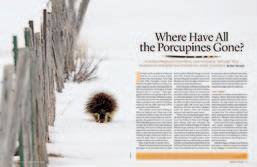
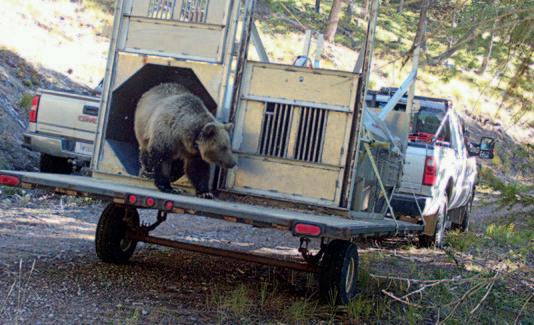
We welcome all your comments, questions, and letters to the editor. We edit letters to meet our needs for accuracy, style, and length. Write to us at Montana Outdoors, P.O. Box 200701, Helena, MT 59620-0701. Or email us at: tdickson@mt.gov.
 By Jim Pashby
By Jim Pashby
1 T. plus 4 T. butter
2 slices bacon, preferably thick-cut, diced 2 bunches (1 ½ lb.) mustard greens, kale, or collard greens, stems and center ribs discarded and leaves halved
Salt and pepper
Four 6-oz. fillets of walleye, sauger, yellow perch, freshwater drum, or similar fish
3 c. buttermilk
1 sprig fresh tarragon or 1.5 t. dried Juice of 1 lemon
1 T. fresh chives, finely chopped (optional) Crusty bread or mashed potatoes
Melt 1 T. butter in a large sauté pan over medium-high heat. Add bacon and cook until almost crisp. Add greens and toss until they begin to wilt. Add about ¼ c. water and cook, covered, for 5 minutes, stirring occasionally. Remove lid and continue to cook until the greens are just tender and most of the liquid has evaporated. Season with salt and pepper, remove to a bowl, and keep warm until ready to serve.
If you’re lucky or skilled enough to catch a few walleye (or sauger, perch, freshwater drum, northern pike, or other white-flesh fish), this is a wonderful way to prepare the fillets for family or guests. The recipe comes from Jonathan Miles’s excellent The Wild Chef fish and game cookbook. My sevenyear-old edition has two dozen bookmarked recipes stained with gravy, oil, and butter from years of use. Miles writes: “Poaching fish in buttermilk—a technique pioneered by New York superchef Jean-Georges Vongerichten—yields the familiar melt-away texture and pure flavor, but with a more sinful richness—and a poaching liquid you’ll want to lap up with a spoon.”

Miles prefers walleye for the dish but notes that any fish will be transformed with his method. I caught two nice drum last summer in the Marias River where it enters the Missouri near Loma and prepared the fillets this way. Yum.
Serve with crusty bread or mashed potatoes to sop up the scrumptious sauce. n
—Jim Pashby is a writer in Helena.
Season the fillets and place them in a single layer in the sauté pan. Pour buttermilk over fillets, add tarragon, and place over medium heat. When the liquid begins to simmer, cover and cook for 2 minutes. Gently roll fillets over and cook for another minute, until the fish is firm but not falling apart. With a slotted spatula, remove fillets to a plate; keep warm.
Discard tarragon sprig and transfer buttermilk, which will have separated, to a blender with the remaining 4 T. butter. Whiz until the butter is smoothly incorporated and the buttermilk is no longer separated. Add lemon juice, salt, and pepper to taste.
Place the greens in a shallow bowl and top with the fish. Pour some buttermilk on top. Sprinkle with chopped chives and serve. n
The 2023 Legislative session has come and gone, leaving in its wake several important bills related to Montana Fish, Wildlife & Parks bills that passed and many more that didn’t.

In our view, the biggest success was passage of SB 295. This legislation is a critical step toward federal grizzly bear delisting, at least for the Northern Continental Divide Ecosystem population, because it defines a portion of the state regulatory framework for managing and conserving bears required by the Endangered Species Act.
Among other things, SB 295 directs the Montana Fish and Wildlife Commission to adopt “administrative rules” describing circumstances and the regulatory structure under which bears can and can’t be killed. Those rules will ensure that grizzly populations remain healthy and above recovery levels while allowing ranchers discretion to kill grizzlies in more conflict situations than allowed now under federal management authority.
To understand how SB 295 fits in with the other steps Montana has taken to fulfill ESA delisting requirements over the past two decades, see “Ready for the Handoff” on page 24.
Other important bills making news during the session include:
Montana’s two-year budget bill. Governor Gianforte’s bu dget included broad support for conservation and recreation work across the state, including $7 million for the FWP Block Management Program, $12 million for Habitat Montana, $12 million for various habitat and conservation projects, $3 million for work on sites on the lower Yellowstone River, and $5 million for improvements to Makoshika State Park.
Hunter education field days. A bill to mandate in-person field days for the FWP Hunter Education Program was voted down in the Senate. The bill initially sought to mandate an in-person field day, but was later amended to mandate full in-person courses for hunters under 18.
In-person field days are an excellent idea, and though the bill was voted down, the strong support it had through much of the process was definitely noteworthy. FWP will be requiring in-person field days for Hunter Ed students age 18 and younger this year.
Right to hunt, fish, and trap. A constitutional referendum to enshrine the right to hunt, fish, and trap in the state constitution fell a few votes short of advancing to Montana voters. Proponents argued it would help curb citizen initiatives like those aimed at banning trapping on public lands. Opposing the bill were Montanans against trapping, as well as others who voiced concern that the constitutional rights could increase private land trespassing.
Block Management payments. A bill supported by hunting groups and landowners to double the payment cap in Montana’s Block Management Program passed and was signed into law. Qualifying landowners may now earn up to $50,000 each year in compensation for accommodating public hunting access. The bill is a key part of how FWP is improving the Block Management Program.
Nonresident hunters. The Legislature considered various bills in response to residents’ concerns about increased nonresident hunting presence and competition between the two groups for hunting opportunities. One that passed with strong bipartisan support will limit the number of antlerless deer licenses available to nonresidents.
Elk hunting access. A bill to make an important change to the “454” program—named for its original legislation in 2001— passed the Legislature with strong bipartisan support. The program had been adjusted during the 2021 Legislative session to give qualifying landowners a hard-to-draw bull elk permit in exchange for allowing three public hunters on their property, rather than four as previously required. The 2023 change ensures that at least one of the three public hunters on each property will get a chance to harvest a bull if the landowner also receives a bull permit.
I was especially pleased that outfitters and hunting groups worked out differences on this and several other issues before the session began. Such foresight and cooperation go a long way toward convincing lawmakers to pass bills.
A few others. A bill to allow the use of crossbows during Montana’s archery season was voted down. So was a bill to repeal the FWP/Montana State Prison pheasant-rearing program, created during the 2021 session. A trio of bills aimed at expanding the use of snares to trap wolves, extending wolf trapping seasons, and allowing the use of hounds for spring black bear hunting died on the House floor.
Overall, Montana fish and wildlife resources and their management fared well during this past legislative session. One thing I noticed at the capitol this year was more consensus and cooperation among people who value hunting, fishing, other outdoor recreation, and conservation. Groups representing landowners, outfitters, hunters, and anglers collectively worked on common legislation to benefit the state.
No one got everything they wanted. But that’s always the case. The politics of fish, wildlife, and outdoor recreation management is about compromise, and never more so than when the Legislature is in session.
I’m originally from northern California and moved to Havre on a football scholarship for the University of Montana Northern. I earned a bachelor’s degree in health education there and then a bachelor’s in fish and wildlife management at Montana State University.
Over the past few years, I’ve had several different jobs, including working at an FWP aquatic invasive species check station, as the caretaker at Missouri Headwaters State Park, as the on-site manager at the Beartooth Wildlife Management Area, and then as a biologist for Pheasants Forever in Chinook. Last year, this FWP recreation manager position based in Miles City opened up, and I was fortunate to land it.
My job involves a lot of driving across eastern Montana. I manage 15 FWP fishing access sites, mostly on the Yellowstone River, as well as Pirogue Island State Park just downstream of Miles City and Medicine Rocks State Park in the state’s far southeastern
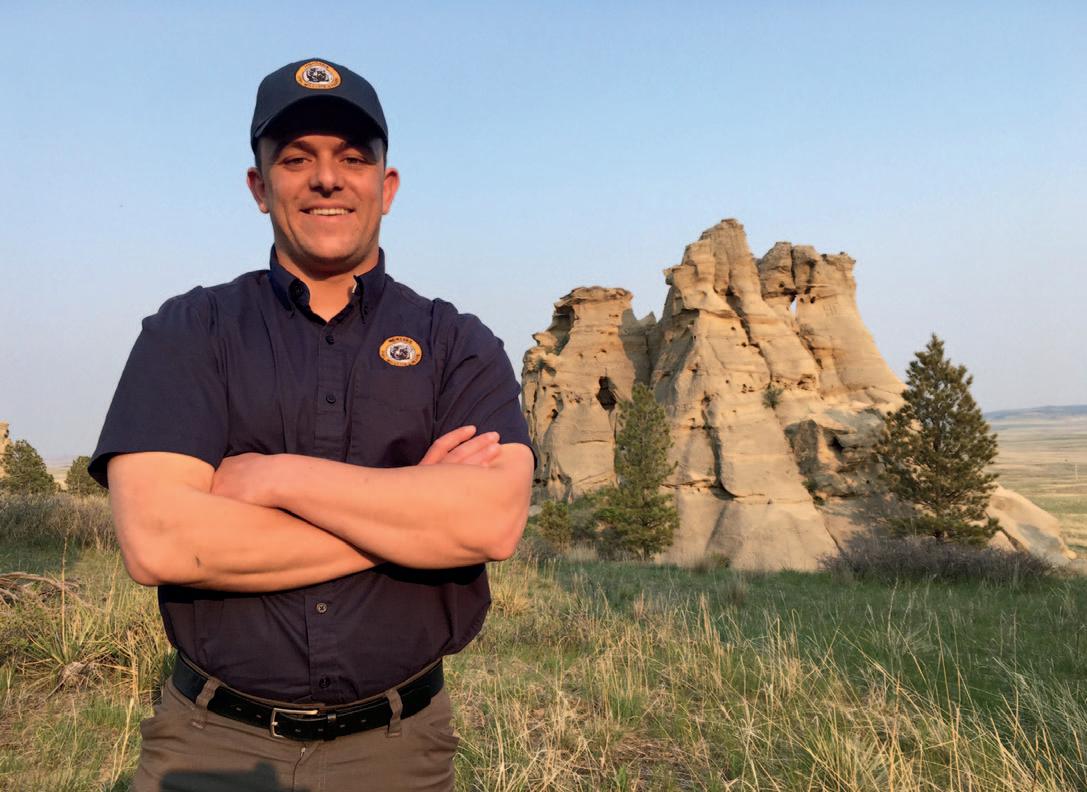
corner. I’m also involved in the department’s new Lower Yellowstone River Recreation Project, helping find new FWP water access areas along the river.
The work at Medicine Rocks is especially gratifying because it’s such a significant site. Medicine Rocks has long been a place of spiritual significance for Native people, was an important landmark for pioneers, and is a huge source of local pride.
In 2020 the park was designated as an International Dark Sky Sanctuary by the International Dark-Sky Association, one of only nine such “darkest of the dark” sites in the entire United States. Over the past two summers, the park has received from 2,500 to 4,000 visitors per month, much of that for night sky viewing. To help manage the growing interest, we recently received a grant to put in a new parking lot, a night sky viewing area where we hold nighttime programs with the Ekalaka-based Carter County Museum, and a three-quarter-mile trail.
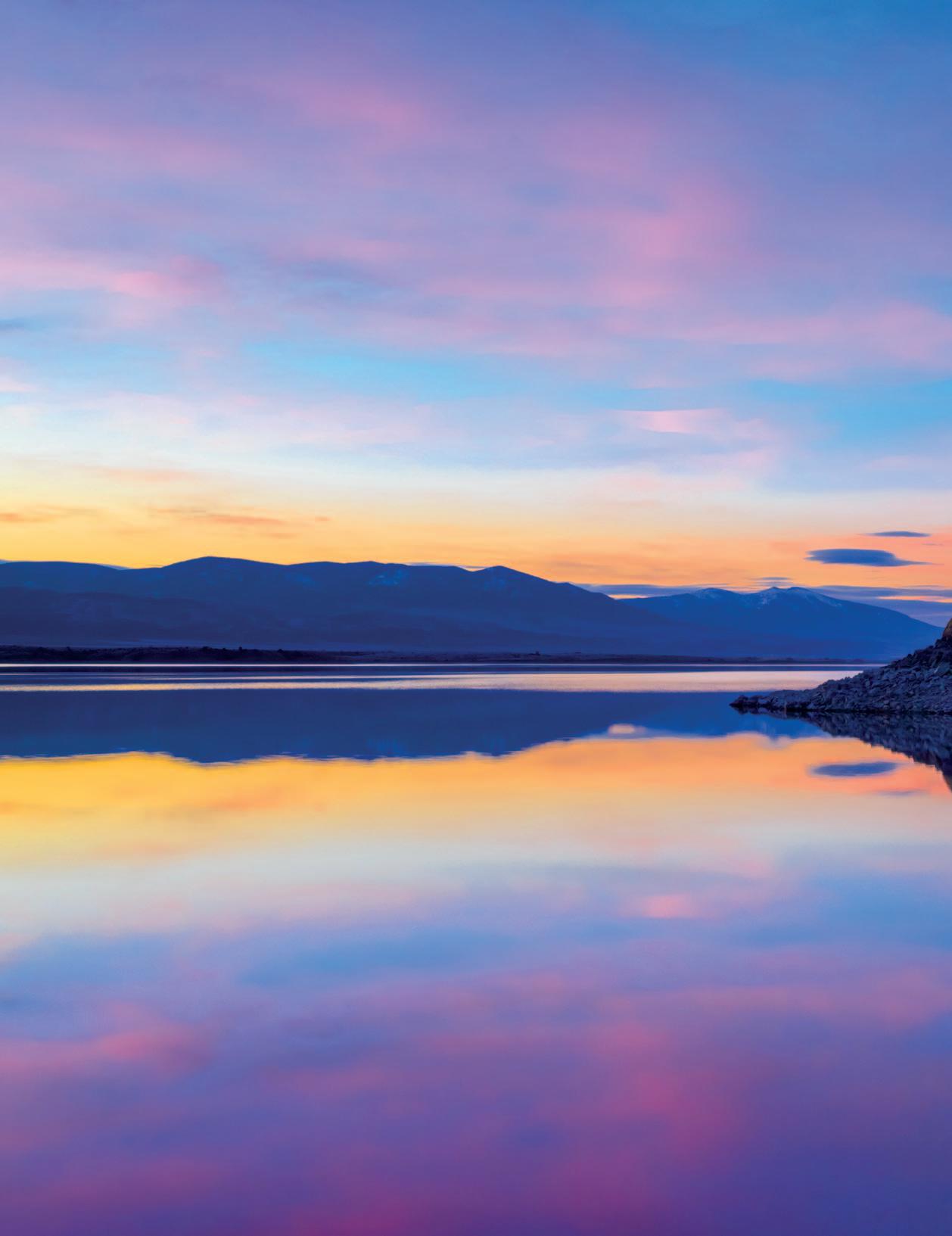
In the early days of the COVID pandemic, when health officials were telling people to self-isolate, Helena photographer John Lambing took their advice and headed to nearby Canyon Ferry Reservoir. “I was walking along the shoreline just before the sun rose and saw this lone ponderosa pine with a reflection off the water, which was dead calm, and that beautiful pink light in the background,” says Lambing, a retired U.S. Geological Survey hydrologist. “I ran along the shoreline trying to get a good composition and was able to take a few shots with an ultrawide lens that captured the entire scene before the sun came up and washed everything out.
“I later sent the photo to some friends back in my hometown of St. Louis and wrote, ‘This is how we self-isolate in Montana!’” n

2.5
Number of students, in thousands, who visited FWP’s Montana WILD Education Center in Helena in 2022 to take part in nature learning programs.

Montana isn’t as notorious for mosquitoes as many southern or midwestern states, but we’ve got plenty. Mountain meadows, the Bighole Valley, and eastern and central Montana grasslands are among the worst spots for getting bit.

Fight back with the best bug spray you can find. According to Consumer Reports, the three most effective repellents are Ben’s Tick & Insect (wipes or pump spray), 3M Ultrathon Insect Repellent, and Off Sportsmen Deep Woods Insect Repellent III.

What about alternative repellents, including wristbands, repellent-infused clothing, clip-on fans, and citronella candles? “Don’t bother,” say Consumer Reports testers. Instead, look for sprays and wipes containing at least 15–30% (but no more) DEET or 20% Picaridin. The best all-natural repellents contain at least 30% oil of lemon eucalyptus, but these last only one hour compared to six hours for the toprated repellents. n
It’s official. Governor Greg Gianforte signed a bill in mid-May designating the huckleberry as Montana’s official state fruit. Students at Vaughn Elementary School in Cascade County lobbied the governor to support the bill.

Hucks now join the ponderosa pine (state tree), bitterroot (state flower), mourning cloak (state butterfly), and grizzly (state mammal) as the way Montana represents itself to the world.
Celebrate the huckleberry’s new status by getting out this summer and picking a few
quarts yourself. Most years the best picking is in the Flathead and Kootenai national forests in northwestern Montana. But that region is still in severe drought, so consider trying the SeeleySwan Valley this summer. Peak picking starts in mid-July and continues well into August. Search forests with roughly 50 percent conifer cover at 3,500 to 7,000 feet elevation.
Note that people aren’t the only ones after the berries. Be sure to carry bear pepper spray and make lots of noise to reduce chances of startling a grizzly. n
Lewis and Clark Caverns, Giant Springs, First Peoples Buffalo Jump, Makoshika, and Flathead Lake get the most press and visitation. And for good reason. But Montana is home to 50 other state parks, many just as scenic, historic, and fun to visit as the better-known sites. Here are three sites off the beaten path to consider visiting this summer or fall:
Lost Creek: This pretty little park a few miles northwest of Anaconda features a shaded canyon for hot summer afternoons, bighorn sheep and mountain goats in the surrounding cliffs, and a lovely waterfall at the end of a short, paved, wheelchair-accessible trail.
Pirogue Island: This is the only state
park that’s in the Yellowstone River. The island park sits just downstream of Miles City and features trails for hiking and mountain biking, opportunities for birding and shore-fishing, gravelly shoals for agate hunting, and cool, shaded sites for picnicking under tall cottonwoods.
Greycliff Prairie Dog Town: A small site just off Interstate 90 between Billings and Bozeman, Greycliff offers no campsites, shade, or even water. But if the kids are clamoring to see western wildlife and you don’t have much time, this is your spot. Park anywhere along the park’s 1-mile driving loop and wait. In a few minutes you’ll see and hear the little rodents as they pop their heads out of their burrows to investigate the new arrivals. n

Readers thumbing through the pages of Outside, Peterson’s Hunting, InFisherman, and, yes, Montana Outdoors could get the impression that few if any Black, Indigenous, and other people of color kayak, hunt, fish, camp, or otherwise enjoy the outdoors.

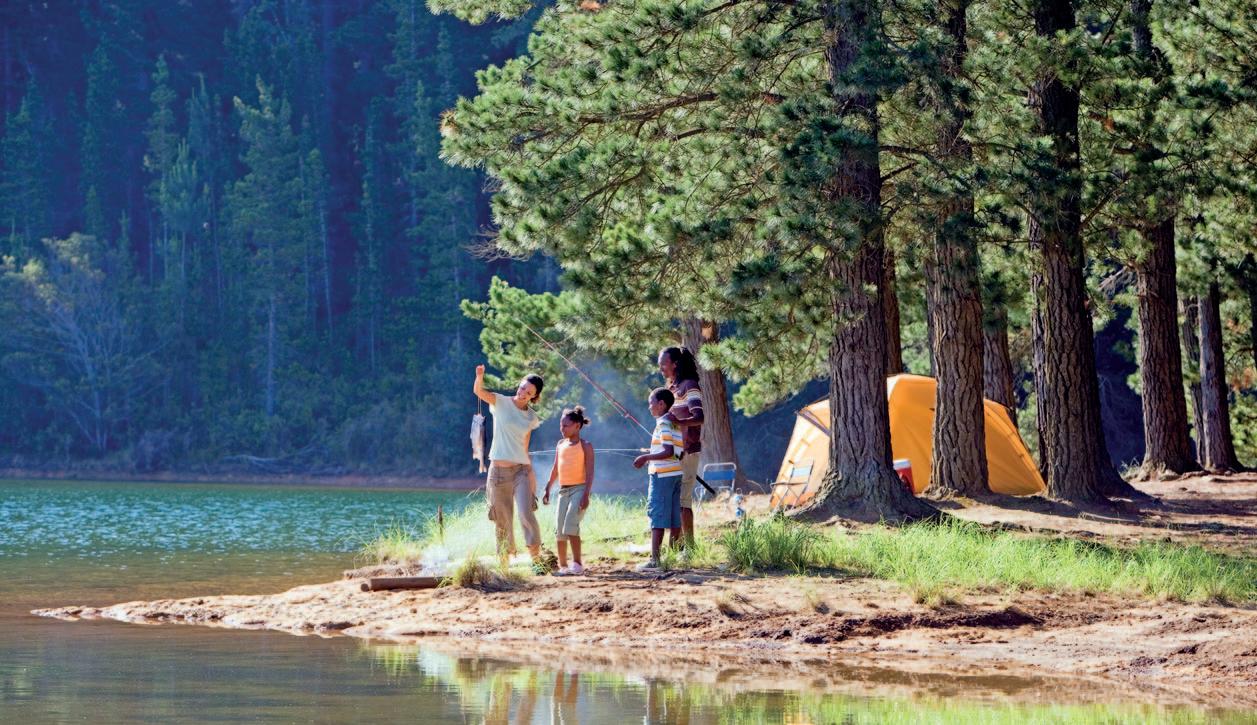
But of course they do, says Rue Mapp, founder and CEO of the nonprofit organization Outdoor Afro, who notes that all people derive the same joy, sustenance, and connection from being in the natural world.
In her new book, Nature Swagger, Mapp is
helping bring that joy to a wider audience. She writes that in the 12 years since starting Outdoor Afro, she and her team have helped tens of thousands of African Americans “camp in the Colorado Rockies…bird watch in the Florida Everglades, canoe in the Mississippi River, and more—all while learning about the long heritage of Black people connecting in nature.”
Nature Swagger inspires Black communities to “reclaim their place in the natural world” as hikers, anglers, hunters, campers, horseback riders, scientists, surfers, beekeepers, and more with stories and essays by 30 people who write about their love of the outdoors.
Contributors include Dr. Rae Wynn-Grant, a large-carnivore ecologist with the National Geographic Society who studies black bears and grizzlies in Montana and writes of how her graduate studies of large carnivores helped her recover from an abusive relationship; John Bur-
roughs Medal finalist J. Drew Lanham, who explains that his passion for hunting deer is not about killing a trophy or even acquiring venison but rather an expression of his love of nature; and Dudley Edmondson, whose life mission is to help Black people recognize their ownership of public lands. “If you’re standing on a mountaintop with millions of acres of public lands laid out below you,” Edmondson writes, “then for all practical purposes at that moment every tree, blade of grass, and body of water on that land belongs to you. That’s very powerful knowledge.”
Doing similar outreach in a different medium are New Orleans zookeeper and wildlife educator Alexi Grousis and actor and wildlife educator Allison Jones, creators of the We Out Here podcast, dedicated to sharing stories of people of color in nature. “I want Black, brown, and Indigenous people to listen and feel seen,” says Grousis, explaining that he aims to help more people like him who love the outdoors feel visible and recognize that nature should and can be enjoyed by everyone.
Find Nature Swagger at local bookstores or online, and We Out Here in the Apple app store. n
Montana WILD’s Corie Bowditch talks about these remarkable members of the cactus family and how spines, a waxy coating, and other features allow them to survive in semiarid climates.


Owlet rescue
Montana WILD volunteer

Diana Longdon tells the story of two owlets rescued from a fallen tree that are recovering with help from a surrogate owl mother.
The creative minds in the FWP Fisheries Division celebrate National Superhero Day by spotlighting the “grime”-fighting and water-cleansing attributes of Montana’s western pearlshell mussel.
The native sauger and non-native walleye are members of the perch family. Both have rounded bodies, sharp teeth, rough scales, cloudy eyes, and sharp spines in the dorsal fin. And both swim in the same waters—the lower Missouri (including Fort Peck Reservoir), lower Yellowstone, Milk, and Tongue rivers. Exceptions are Canyon Ferry Reservoir (walleye only) and the Powder River (sauger only). n
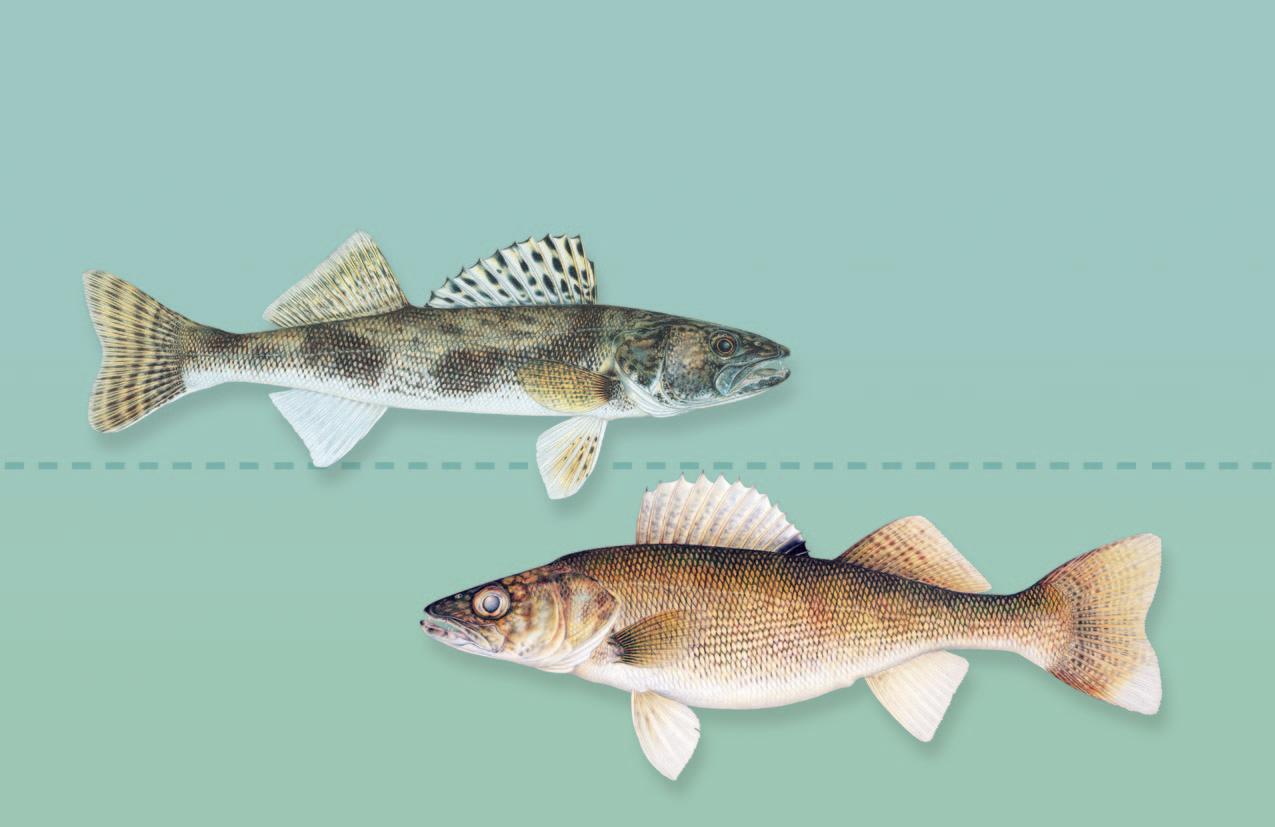
No white on lower tip of tail fin
No spots on front dorsal fin
Walleye
Sander vitreus
Generally fatter than a sauger
Cheek has few or no scales
Front dorsal fin has rows of dark spots
Sauger
Sander canadensis
Generally skinnier than a walleye
Cheek is mostly scaled
Back base of front dorsal fin has dark blotch
Lower tip of tail fin is white
What it is
Leafy spurge is a noxious weed native to Eurasia that has spread west across the United States over the past century.
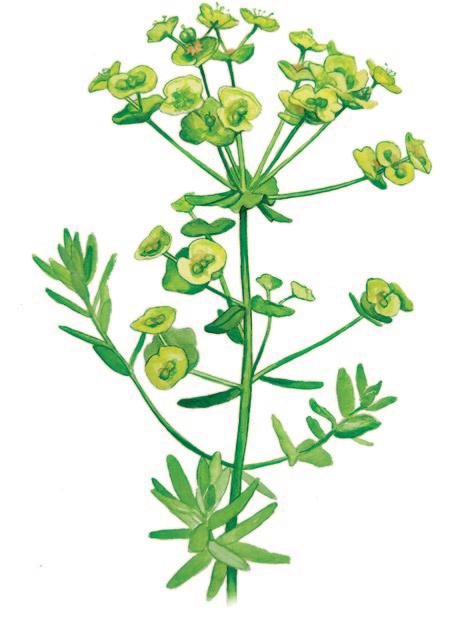
How to ID it
Nicknamed leafy “scourge,” this 2- to 4-foot-tall plant has long, slender leaves and clusters of yellowish-green flowers nestled in cupped structures known as bracts. Stems, flowers, and leaves emit a white, milky sap when broken. This is one of the earliest plants to emerge in spring and among the last to become dormant in the fall, when the leaves turn reddish brown.
Where it’s found
Leafy spurge invades pastures, grasslands, roadsides, and stream banks across Montana. It grows in full to part sun in a wide range of soil types and moistures but is especially aggressive in dry sites.
Why we hate it
Stands of leafy spurge crowd out native vegetation. The weed is inedible to wildlife and toxic to cattle and horses.
How it spreads
Each plant produces large clumps of shoots from extensive underground stems and roots, allowing it to quickly dominate other vegetation. To make matters worse, each plant produces
A quick look at concepts and terms commonly used in fisheries, wildlife, or state parks management.
One of the biggest challenges to conserving Montana’s native cutthroat trout (westslope and Yellowstone) is preventing or reducing hybridization with non-native rainbow trout.
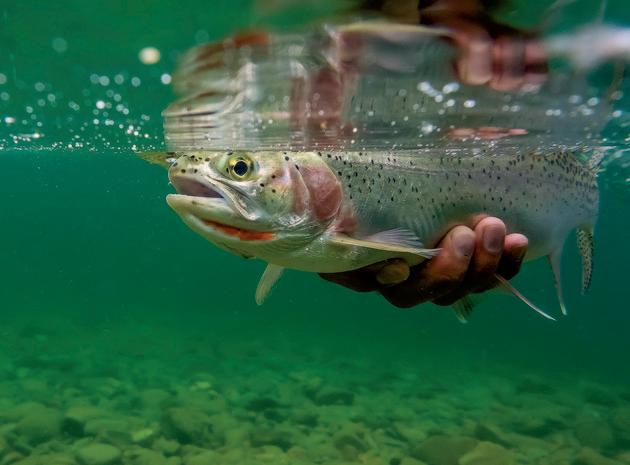
The problem with hybridization, or crossbreeding, is that it reverses millions of years of evolutionary isolation and specialization between species. Not only that, but multiple studies have provided evidence that cutthroat trout have higher survival and reproductive success in their native range than rainbows and hybrid “cutt-bows.”
FWP’s responsibility to protect native species as part of Montana’s natural heritage requires working to reduce unnatural (human-caused) hybridization among species, especially when caused by historical management activities like fish stocking. Over the past century, the distribution of westslope cutthroat across the West has dropped to less than 10 percent of its historic range, due to habitat loss, competition from non-native brook trout, and rainbow trout hybridization.
seeds that “explode” from seedpods, spreading up to 15 feet in addition to being carried farther by wildlife, wind, floodwaters, and vehicles. The plant also spreads in commercial mulch, feed grains, crop seed, topsoil, and gravel.
How to control it
Young seedlings can be hand-pulled. But once an extensive root system develops, stands must be treated with herbicides, targeted grazing, or predaceous insects. Consult your county weed coordinator for eradication instructions.
Learn more at mtweed.org. Illustration by Liz Bradford
One way to protect native stocks is to build barriers that keep rainbows from moving upstream into some of the last cutthroat strongholds. Another is to use natural, temporary fish-killing compounds to remove all rainbows and hybrids from a stream or lake and then stock it with nonhybridized cutthroats. n
THE MICRO MANAGERn many ways, my adult life has revolved around mountain bikes. I’ve owned six so far. Two were stolen. One tumbled down Interstate 90 when a swift wind caught the cheap rental bike rack that was inexpertly attached to my car. My other three survived to their retirement, but not without damage incurred by my neglect.
I’ve been on mountain bike dates, mountain bike outings with toddlers, mountain bike vacations. One of my first professional jobs was as the mountain biking editor for Falcon Publishing. And I’ve raised a son who recently returned from his first college spring break trip to Moab, Utah, the mecca of mountain biking. Of course, now he wants a fancy new mountain bike.
Who can blame him? Mountain biking is a fun, healthy outdoor activity. It boosts your heart rate, improves your balance, produces far less knee stress than running, and gets you to some of Montana’s most scenic landscapes.

That’s not to say the sport is easy, or always safe. Mountain biking requires leg strength, balance, and alertness. Accidents can happen. I’ve had my chin stitched up twice after flying over my handlebars going downhill, and I nearly gave up mountain biking altogether last year after a clueless rider soared off a jump and nearly landed on my head.
All this might make it sound like I’m an expert cyclist. I’m not. I’m still nearly as awkward on a mountain bike as when I pedaled my first rigid Trek 850 more than 30 years ago. While mountain biking equipment has evolved tremendously since then, my confidence hasn’t. The steep, rock-strewn switchbacks are as scary as ever,


Mountain biking is booming across the West, especially in areas like Helena, designated one of America’s premier off-road cycling communities.
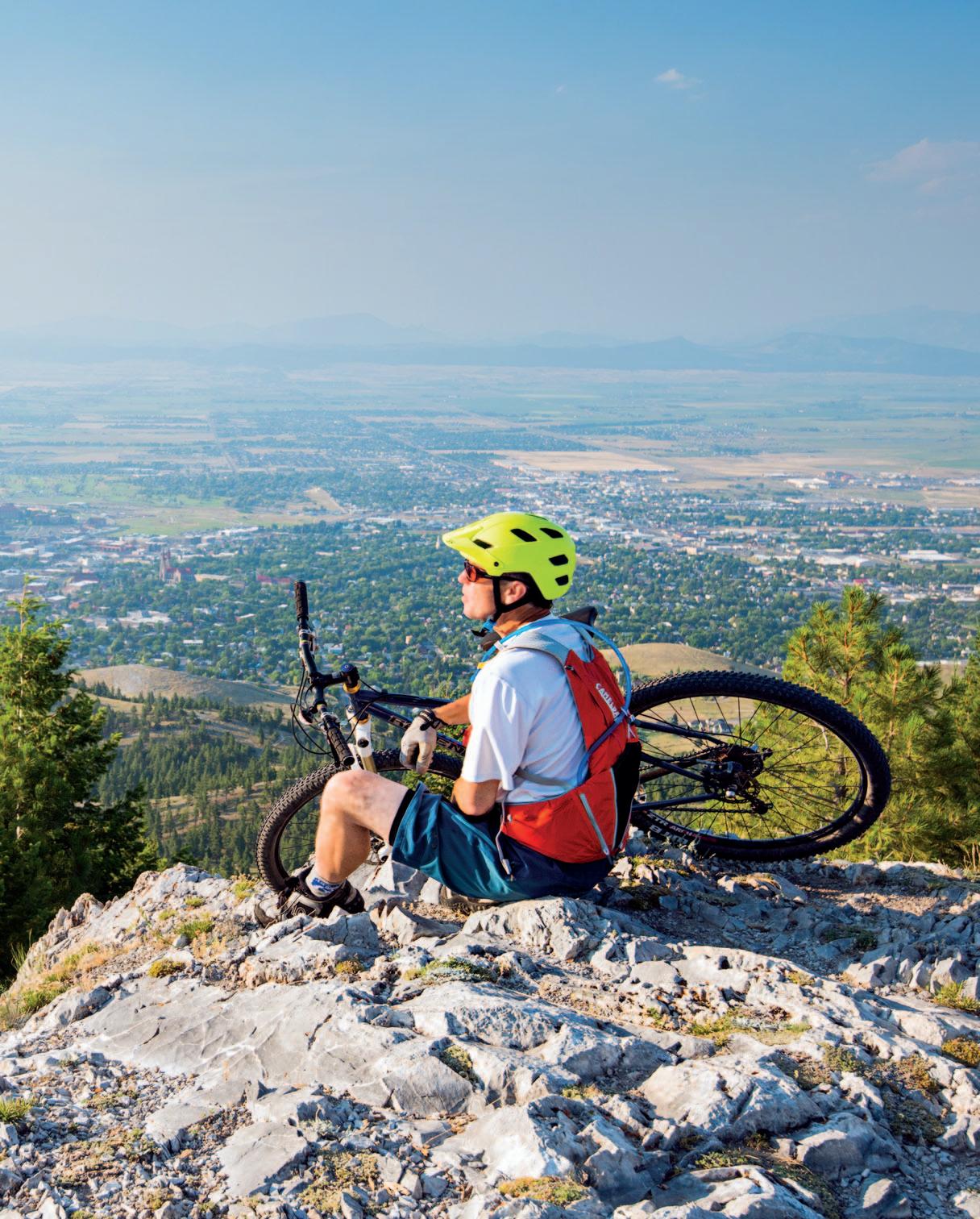
even though I now own a full-suspension bike with disc brakes.
But I’ve learned a lot about mountain biking over the past three decades. And for most of that time, I’ve lived in Helena, one of the nation’s top mountain biking communities. I’ve watched the Queen City’s trajectory to off-road cycling stardom, and learned how that rapid rise reflects the sport’s popularity elsewhere in Montana and across the West.
Though most people consider mountain biking a relatively new form of outdoor recreation, the use of all-terrain bicycles in Montana dates back to the late 19th century with the formation of what were nicknamed the Iron Riders, or Buffalo Soldiers. The allBlack 25th Infantry Regiment Bicycle Corps rode bicycles from Montana to Missouri in 1897, a 1,900-mile journey. According to a
2022 Smithsonian article, Lieutenant James Moss, who was stationed with the infantry in Fort Missoula, wanted to test how troops and bikes could handle the West’s rough terrain.
Riders today might brag of “getting stoked” about a brutal ride or thrilling downhill, but the Buffalo Soldiers made one of the gnarliest trips ever recorded. “During their 41-day journey, the cyclists pedaled up mountains, through forests, over deserts and across rivers, riding on dirt trails, unpaved roads and railroad tracks…,” wrote author David Kindy. “They biked upward of 50 miles per day, alternatively enduring snow, freezing sleet, hail, heavy rain and oppressive heat.”
All this on single-speed bikes.
Various types of off-road and mountain biking evolved from there. Starting in the early 1900s, “cyclo-cross” racers in Europe pedaled standard road-racing bikes with knobby tires across rural countrysides— a grueling sport still popular today. Starting in the 1960s, innovative cyclists in Oregon,


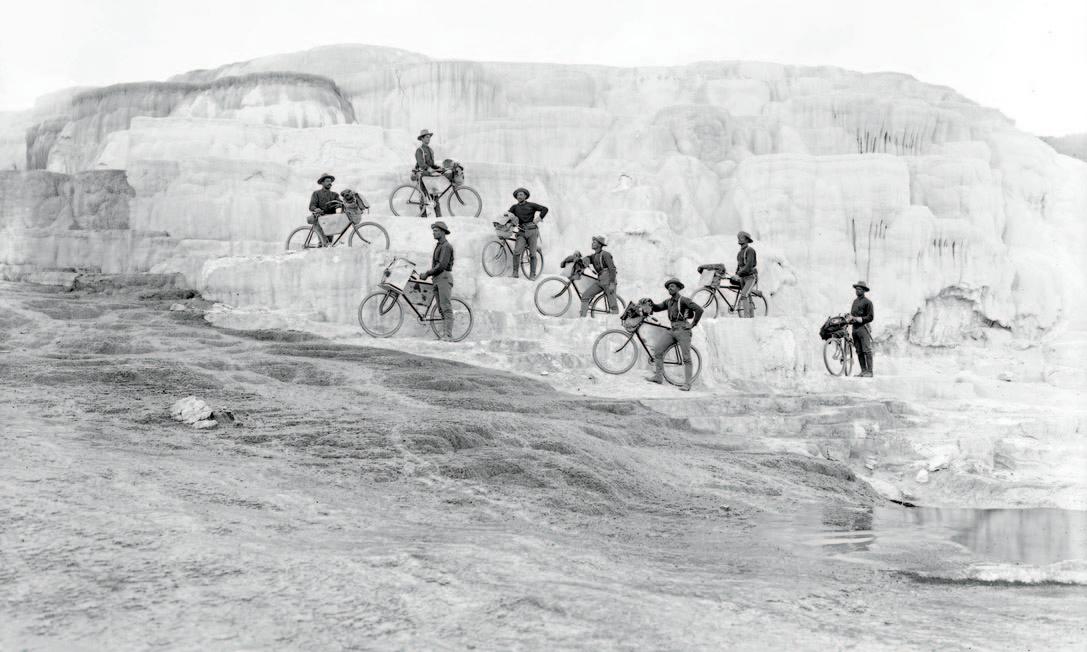
California, and Colorado began experimenting with off-road bike designs. Jim Barnes, owner of Big Sky Cyclery in Helena, witnessed the evolution firsthand. “We wanted bikes to ride up mountains,” he says. In the late 1970s, while working at a Missoula bike shop, Barnes and his co-workers began modifying single-speed Schwinn Cruisers with gears that made uphills easier. “We rode what we could and pushed what we couldn’t,” he says.
Emmett Purcell, also of Helena, started pushing his BMX bike up Mount Helena in 1977 when he was 12. A few years later, he was one of the few mountain bike racers from Montana competing on the National and World Cup circuits. By the 1990s, he was featured on the covers of cycling magazines. “I chased the racing thing pretty good,” Purcell says. After his racing days
were over, Purcell gave back to the sport by building and maintaining trails.
Mountain bikers riding Helena’s extensive South Hills Trail System can experience Purcell’s handiwork on the epic Entertainment Trail on the back side of Mount Ascension and the trail that bears his name—Emmett’s Trail—a few miles south of Mount Helena, right in the city’s backyard. You can even celebrate a day spent in the South Hills with an E-Trail Pale Ale, named for Purcell, at the Blackfoot River Brewing Company.
As mountain biking grew increasingly popular, riders needed advice on where to take their new toys. Montana writer and rider Will Harmon stepped up. He bought his first mountain bike in 1981 with money earned from selling his guitar. “When I got to Bozeman in 1982, it was one of the first mountain bikes in town,” Harmon says. He was featured in a Bozeman Chronicle story that year that declared mountain biking the “next big thing.” Harmon, who has lived in Helena since 1988, went on to write several guidebooks for Falcon, including Mountain Biking Bozeman and Mountain Biking Helena.

Mountain bikes have come a long way from what the Buffalo Soldiers rode more than 125 years ago. Many now have 10 to 12 gears that allow riders to climb steep grades, as well as front-only and front and back shock absorbers (bikes equipped with these are

known, respectively, as hardtails and full suspension models). Not surprising for a fellow who owns a bike shop, Barnes says he owns several different mountain bikes for various conditions—a full-suspension version for playing on the trails, a commuter bike to get to work, a no-suspension gravel bike for exercise and fun on flatter routes, and one with ultra-wide tires to cycle through snow.
“Mountain bikes are now the standard bike for most people,” Barnes says. “The sport caught fire in the ’90s and leveled out in the
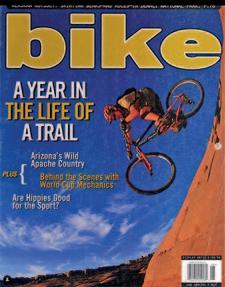


2000s. But with the introduction of full suspension and better brakes, it started growing again in the last 10 years.”
Part of that growth comes from local efforts to promote trails to tourists and residents alike. Around 2011, the Helena Tourism Office hired marketing specialist Pat Doyle, now the marketing manager for Montana Fish Wildlife & Parks. Doyle conceived of a “Bike Helena” brand to promote the town’s
“We have such a nice place to play, we want to take care of it.”

FWP manages more than a dozen state lands offering mountain biking trails. Find directions and maps at fwp.mt.gov. Note that some wildlife management areas (WMAs) may have closed areas, closed times, and other restrictions.

abundant off-road cycling routes.
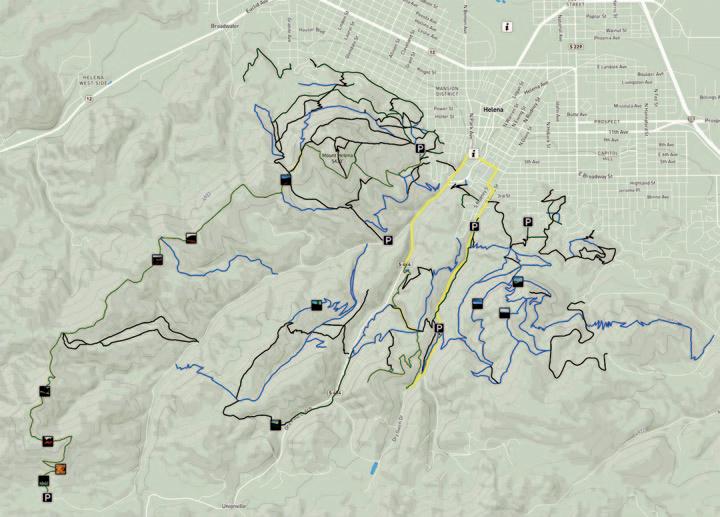
“Helena is not a resort town, and it’s a full hour off the main interstate crossing Montana,” Doyle says. “But we have immediate front-country access that is linked by an incredible trail system. There’s a trailhead at the end of almost every road in this town.”
Over the previous two decades, community leaders had improved Helena’s beauty and livability by conserving open space and expanding the multi-use trail network. Doyle invited national biking magazine writers and photographers to the Queen City. And he, with Purcell and cyclist and photographer Bob Allen—who was inducted into the International Mountain Biking Hall of Fame for his photos of national and international races— applied to designate Helena an International Mountain Biking Association (IMBA) “Ride Center.”
Doyle then assembled a group of elected officials, small business owners, and other community leaders to meet with IMBA
officials and show their support. After the IMBA team visited Helena and rode the South Hills Trails System, it declared Helena a Bronze-Level Ride Center. The group’s website describes Ride Centers as “the pinnacle of mountain biking communities [where riders] will love the extensive variety of high-quality rides, plus plenty of fun beyond the trails.”
A year later, the IMBA bumped Helena’s designation up to Silver Level Ride Center, joining 15 other similarly honored communities worldwide, including Sun Valley, Idaho; Livigno, Italy; and Taupo, New Zealand. “There’s no question that cycling is a huge part of our town,” Doyle says. “Our trail system is attracting people from outside the community while instilling local pride and participation.”

Mountain biking’s appeal in Helena and elsewhere is also multi-generational, Barnes says. One of the biggest changes he’s seen in recent years is an aging clientele. “More older people are biking,” he says. “I am also



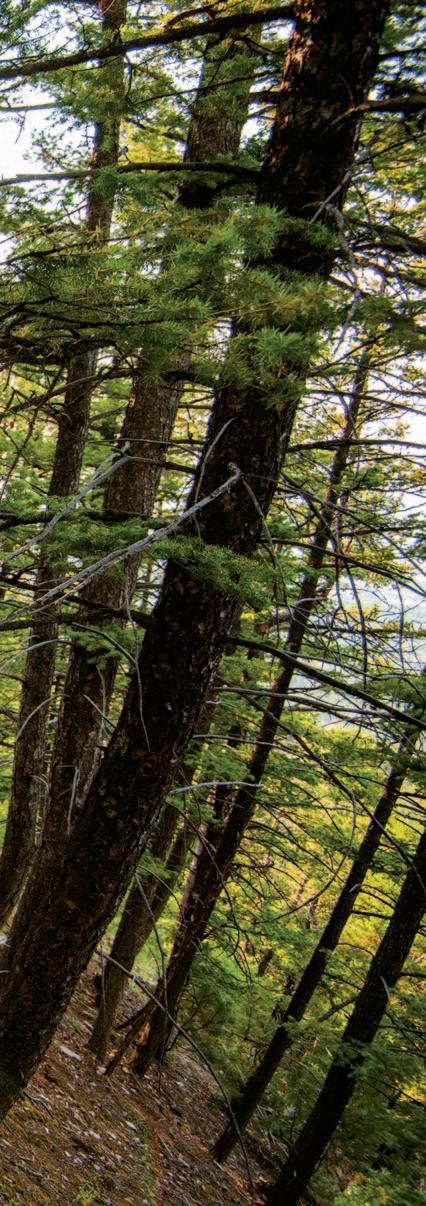
“ There’s a trailhead at the end of almost every road in this town.”SO MANY OPTIONS Helena’s vast network of trails lace national forest land to the south and west of downtown. A fee shuttle service drives cyclists and their bikes up to several trailheads. AARON THEISEN Cruising the scenic Eddye McClure trail in Helena’s South Hills Trails System.
seeing generations of families. Someone who bought a bike in the ’80s now comes in with their kids.” Harmon passed down his passion to his son, Evan, who manages a mountain bike shop in Missoula.

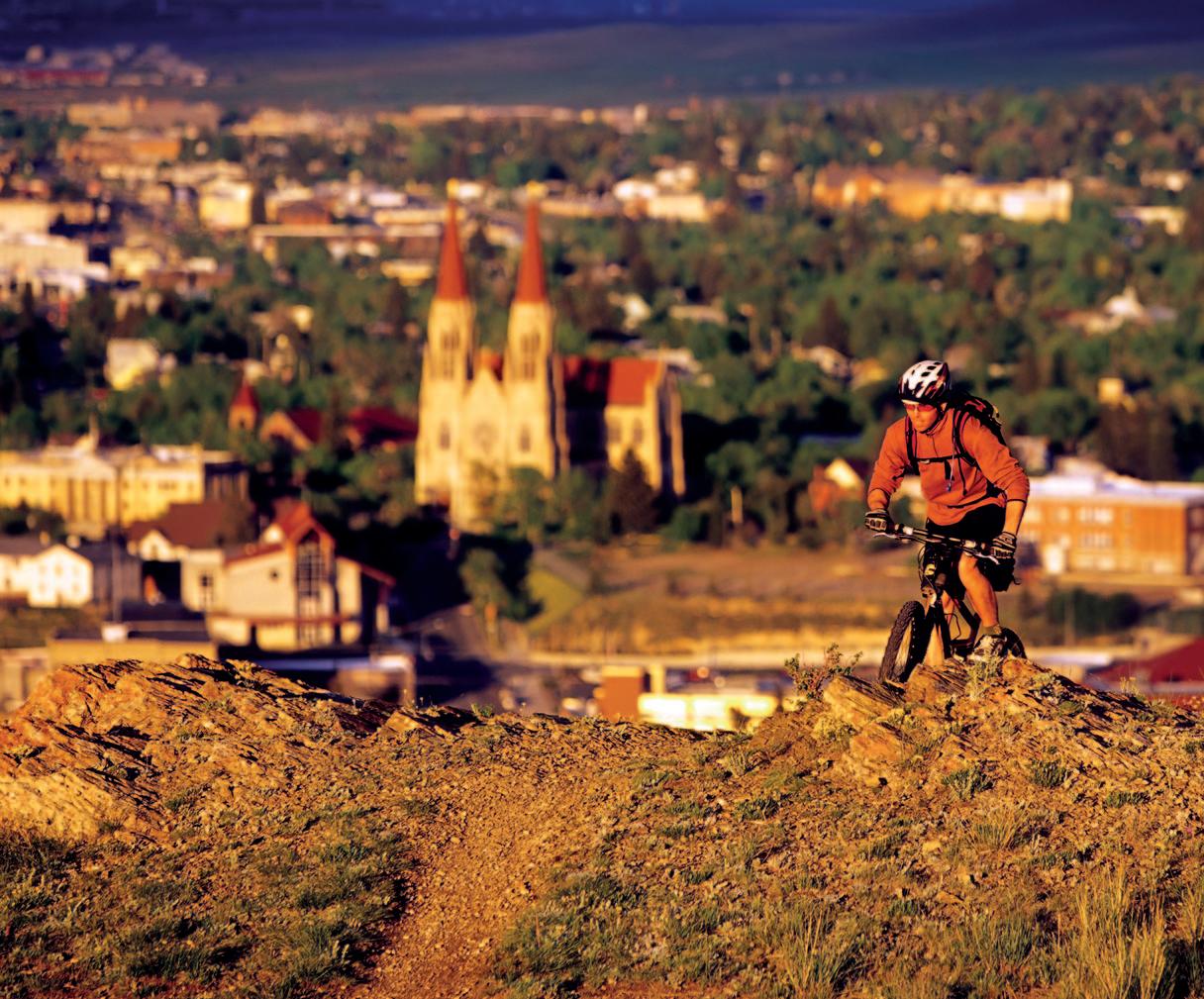
Increased trail use, especially by families, requires greater levels of patience and respect for other users. Since 2015, Mary Hollow has been executive director of the Helena-based Prickly Pear Land Trust (PPLT), which developed and maintains the South Hills Trails System. She says conflicts between trail users sometimes occur, but most hikers, trail runners, and mountain bikers are tolerant and
“Our trail system is attracting people from outside the community while instilling local pride and participation.”FROM TOP: CHUCK HANEY; PAUL QUENEAU
respectful of each other. “When I started here, trail etiquette just wasn’t an issue,” she says. “But with the growing use of the system, there’s far more awareness of the importance of outward kindness. People understand the need to smile, or to wave or say ‘Hi,’ or to move off the trail when someone wants to get past,” she says.
Trail users have also stepped up to help maintain these well-loved playgrounds. PPLT hosts volunteer work days—often led by Purcell—during warmer weather. “There has been a huge increase in volunteer trail days,” Hollow says. “People are really recognizing the value of their public lands and trails and that the trails need to be
Bozeman’s Bangtail Divide Trail
Butte’s Beaver Ponds Trail
Big Sky’s Grizzly Loop
Whitefish Trail
Great Falls’ South Shore Trail
Missoula’s Rattlesnake Loop
Great Divide Mountain Bike Loop
Also, Montana’s Big Sky, Snowbowl, Whitefish, and Discovery ski resorts offer chairlift rides to the top of their mountain biking trails for (mostly) downhill rides.
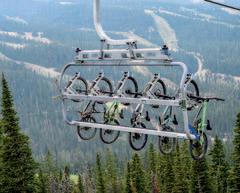


In 2016, a mountain biker was killed by a grizzly bear while riding in the Halfmoon Lakes area of the Flathead National Forest west of Glacier National Park. Officials believe the rider hit the bear unexpectedly while pedaling downhill around a bend. Grizzly bears can be almost anywhere west of the Continental Divide, and in recent years the population has expanded into historic range as far east as Interstate 15 and beyond.

Tips for cycling in bear country:
u Slow down and look ahead, especially in areas of dense vegetation, in berry patches, and around blind corners.
u Ride in daylight and in groups.
u Make noise! Let bears hear you, especially where visibility is limited.
u Carry quickly accessible bear pepper spray
maintained. They want to contribute.”
No one tracks mountain biking participation rates in Montana. But if the growing number of cars with bike racks crammed into trailhead parking lots is any indication, the sport is booming. As an outdoor recreation advocate, I’m excited that more people are discovering the sport’s many benefits. But the growth also poses challenges. Hollow’s report of increased civility on Helena’s trail system is heartening. I’ve seen it myself. Queen City mountain bikers and other users understand that our trails need regular maintenance, financial support, and cooperative use.
Hopefully, that’s happening on Montana’s
other trail systems, too. I’m looking forward to trying as many as possible in the coming years. I probably won’t be cycling for the rest of my life, but I’m pretty sure I have at least one or two good bikes left in me.
Type “mountain biking Montana” in a search engine and you’ll find lots of online information on mountain biking opportunities. One of the best sites is the MTB Project (mtbproject.com), a crowd-sourced mountain biking guide that rates and maps more than 160,000 miles of trails nationwide. The project’s website recommends 56 routes in the Treasure State. For documentaries on the history of mountain bike development, type “mountain bike klunker.”
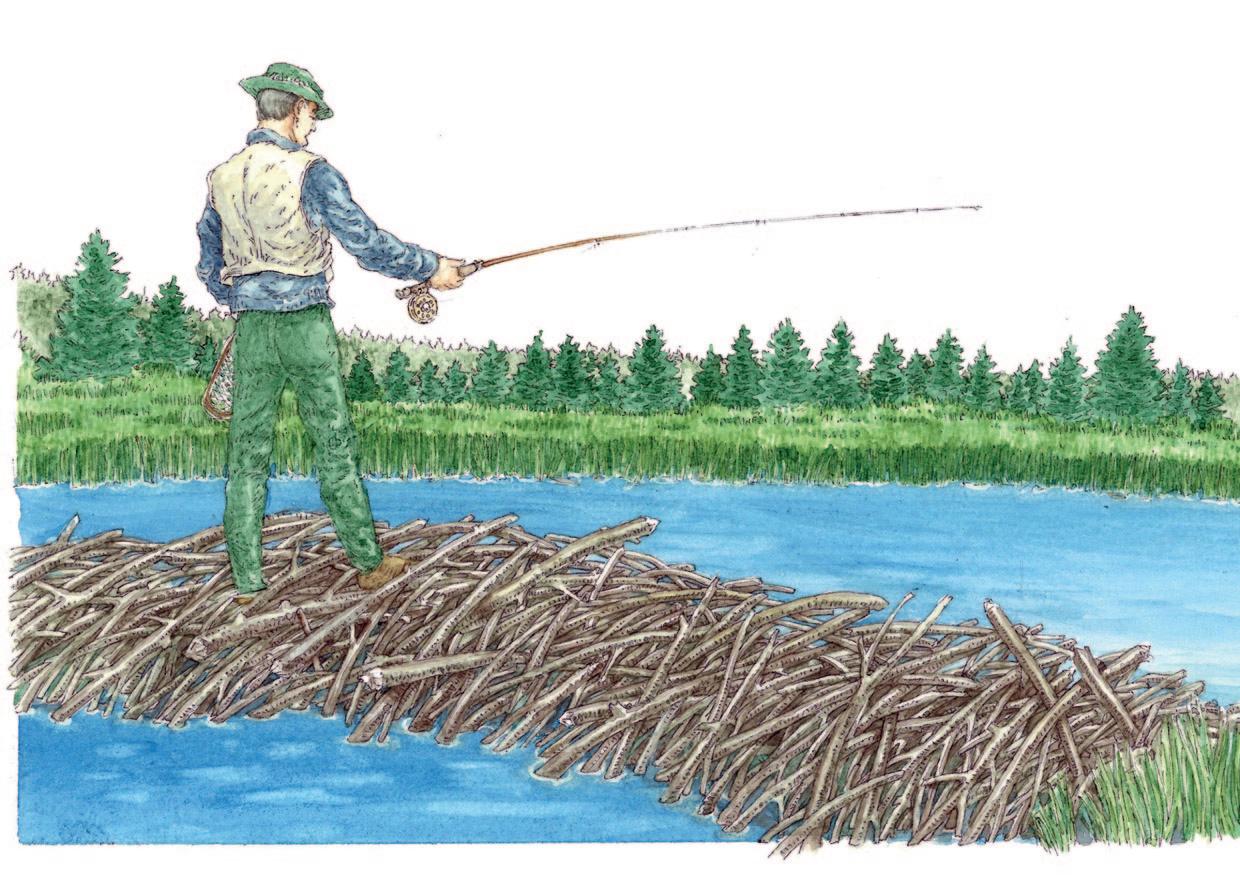 By Ben Long. Illustration by Ed Jenne.
By Ben Long. Illustration by Ed Jenne.
found this particular beaver pond without the help of guidebooks, gossip, or Instagram. Instead, I heard about it from a duck.
I lose things all the time and rarely find them again. And when I occasionally find someone else’s lost item, it’s almost never as nice as the things I’ve misplaced. For example, I have left all sorts of quality pocketknives across North America. I’ve found a few pocketknives, too, but as a rule they are so rusty as to be useless.
The beaver pond is the exception. Here I found something
both utterly unexpected and beyond expectations. People have been tramping across central North America for thousands of years, so any “discoveries” made by explorers in recent centuries have always been partly self-delusional. Even Lewis and Clark were informed about the Great Falls of the Missouri by the Mandan Indians months before viewing the distant mist rise above the prairie. But knowing it was there beforehand didn’t lessen the thrill of seeing the massive 900foot-wide waterfall, what Lewis called “the grandest sight I ever beheld.” They also looked for and found trout below the falls, adding a new species to the record of western science: the westslope cutthroat.
Two centuries of non-Indigenous people settling, mapping, and exploring what we now call Montana have made it even less likely for anyone to stumble upon something undiscov-
ered. These days, exact spots along a stream where anglers pose for maximum clicks on Instagram are geotagged for all to find. So the beaver pond is like my own miniature Great Falls. But unlike the Corps of Discovery, I never saw it coming.
grouse or spruce (Franklin’s) grouse. I take my 12-gauge or .22 there each September to pot a few for dinner.
The setting is the Stillwater River drainage in northwestern Montana. None of the standard Montana clichés apply: no cowboys, miners, or Hollywood refugees; no bison or bison hunters. Here Montana’s Big Sky is squeezed out by towering spruce, fir, and larch.
There are few roads, and the villages of Trego and Olney are little more than built-up railroad sidings. The distant rumble of trains joins the birdsong. The land is not especially mountainous, but it is rugged. Here’s where railroad crews built the longest tunnel in Montana, drilling and blasting seven miles through solid bedrock.
Aboveground, the boreal forest reminds me of how Thoreau described Maine: “all mossy and moosey.” The muddy logging roads are pocked with moose tracks, along with those of white-tailed deer and wolves, and, occasionally, lynx and snowshoe hares. It’s also a good spot to hunt ruffed
When I was still in my 20s, more than three decades ago, I hunted for grouse along a closed logging road until I reached a burbling forest stream. There I heard the unmistakable gabbling of feeding mallards. The sound seemed utterly out place beside a mountain stream, until I realized that it must have been plugged by beavers to create ponds somewhere behind the curtain of alder and spruce.
I had a few steel shot shells in my vest, so I set all my lead shells on the ground—lead can’t be in your possession when using requisite nontoxic shot for waterfowl—slipped the loads into the magazine, and stalked upstream through the woods. Shortly, I emerged into a marshy meadow that I had no idea existed. A small flock of mallards erupted. I fired at the front bird and the third in line fell with a splash. Because I had no dog, it made for a soggy retrieve. But I was tickled all the same.
That was the last duck I shot there, but the pond fell into the seasonal circle of my home range. The dam, several hundred yards long, is a historic relic of heroic rodent labor. The logs
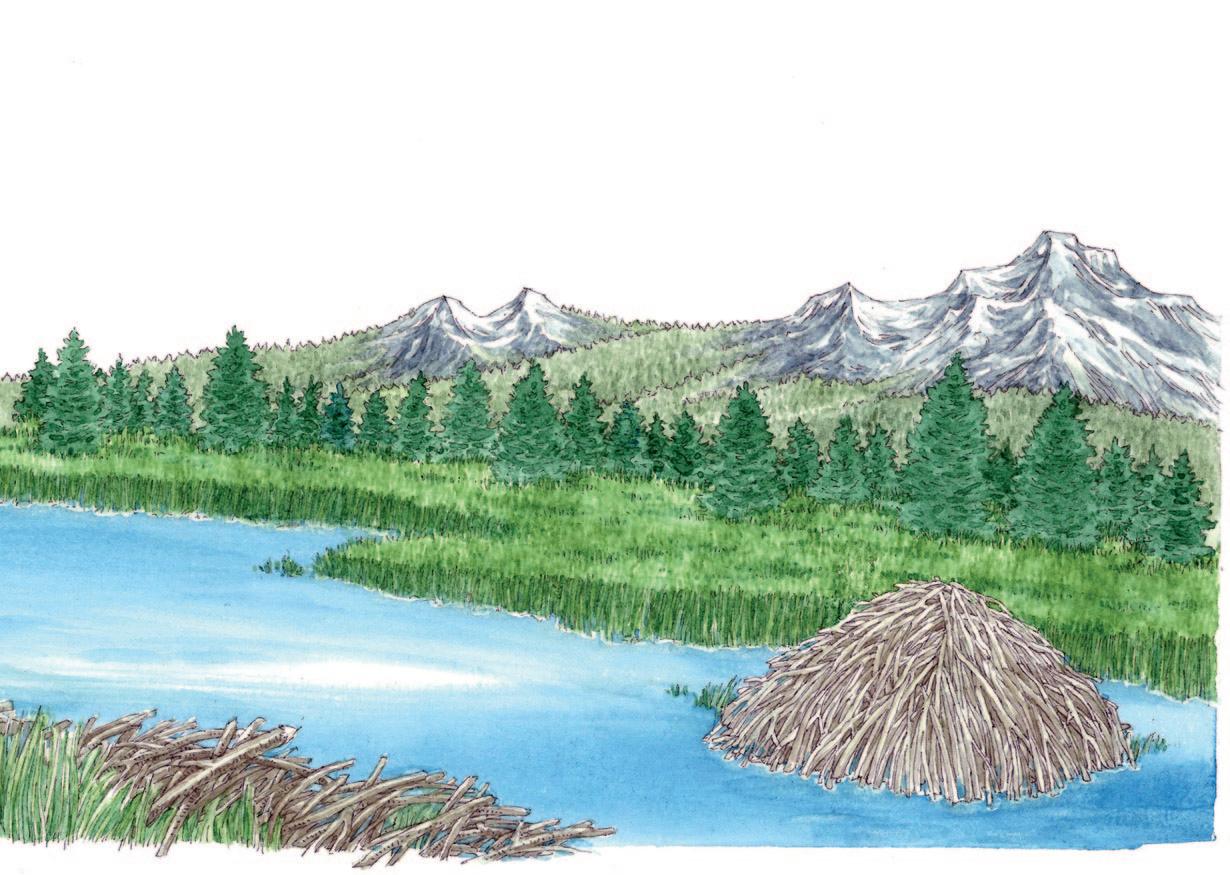
are white and dry, like the bones of some prehistoric giant emerging from the muck and willows. It struggles to impound perhaps five acres of open water, although the surrounding meadow suggests it was once several times that size before sediment gradually filled in the edges. The meadow grass around the pond covers goop that you’d sink into over your head. The waving strands are lovely to look at but better appreciated from a distance.
I have found the tracks of otters, beavers, mink, and bears along the pond’s edges, but never those of another person.
During September grouse seasons, I’d eat lunch on the edge of the pond and fantasize about the Kootenai Tribe moose hunters or Hudson Bay Company trappers who preceded me.
I also asked questions. Not big ones, like, “What’s the meaning of life?” or “Where did we all come from?” I’m content with smaller queries, like, “I wonder if there are any fish in this pond?”
These days, when every fraction of the globe is pixelated by satellite and digitized in “The Cloud,” is there hidden someplace a treasure box of surprise? And, if so, can a 5-weight fly rod pry open the lid?
doomsday gray from forest fire smoke, my wife Karen and I went to a favorite swimming hole, on the main stem of the Stillwater River not far from the beaver pond. As we walked back to the car after our dip, I checked a huckleberry bush to see how the fruit was budding. One branch seemed oddly straight.
I plucked the branch from the brush and found it was a fly rod that had been lost some years before. The cork handle had been chewed by mice and the line was decayed. But the rod was still flexible and the reel said “Sage.” Once home, I gave the reel a shower of WD-40, added new line and backing, replaced the tip eye, and acquired a foundling rod.
Just the thing to test foundling waters.
Like a field scientist, I again pondered my question: Would the beaver pond support fish? A trout would be nice, but any fish would do. My expectations were low. The pond was, after all, a small, warm, silted-in body of water. If it did have fish, I suspected they were mere fingerling brookies.
Come to think of it, my fly rod itself represents another discovery. One sweltering hot summer evening, when the sky was
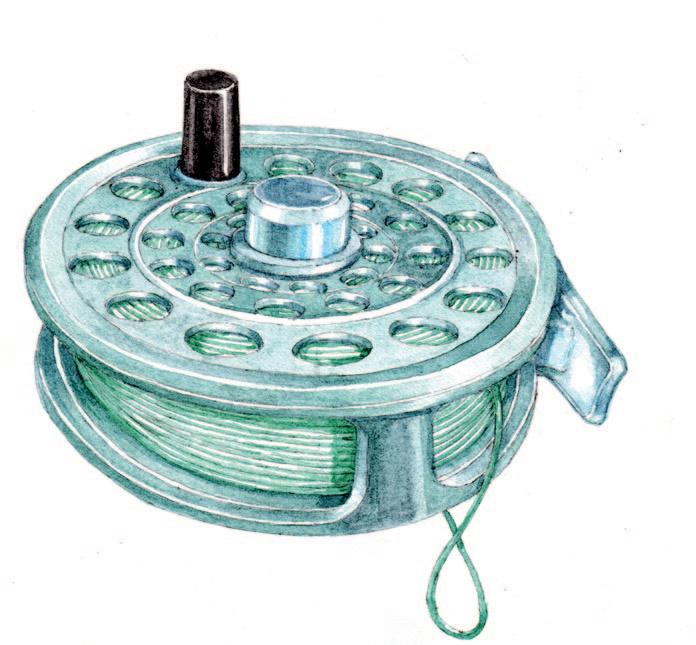
When Lewis and Clark “discovered” the cutthroat trout at Great Falls, they immediately compared them to the fish they knew back home: brook trout. Brookies arrived in northwestern Montana less than a century after the Corps of Discovery and even predate what’s now known as Montana Fish, Wildlife & Parks. Folks on the railroads carried little brook trout in milk jugs of cold water from back East, where the species is native, and dumped them merrily as they passed any body of water.
Some Montana anglers love brookies, claiming they are the best-eating trout of all. But many others malign the species as unwelcome carpetbaggers. They consider them low-rung fish, well below the native cutthroats and bull trout and lacking the glamour of Missouri River rainbows or Madison River browns (both also non-natives).
In part, the low reputation of brook trout comes from the fact that, in so many Montana waters, they become overcrowded and stunted. You can catch them, sure, but they tend to be all head and tail, with skin and bones in between. Kid stuff. But back in their home waters of New England, catching brook trout on a dry fly from a beaver pond is considered sophisticated sport.
One September Saturday, the sky again hazy with forest fire smoke, I tucked my newly acquired fly rod into my grouse-hunting bag. As is my tradition, I ate my sandwich at the pond and eyed bubbles on the water surface. Maybe it was swamp gas escaping the bottom. Or maybe supping fish.
I now viewed my effort as more scientific inquiry than sporting endeavor. I tied an Elk Hair Caddis to the 4X tippet and edged toward the water. My initial backcast lodged in an overhead spruce bough, losing the fly forever.
Undaunted, I carefully walked out onto the rickety dam for a clearer place to cast. Once properly footed, I was able to send a newly attached caddis imitation onto the pond surface. Then I saw the most timid rise, as if a fingerling bumped the fly’s hackle with its nose.
Perhaps the fly was too large. I tied on my smallest imitation, a dry fly the size of a mosquito. It floated lightly before a small splash indicated a take, and the line suddenly went taut.
Eureka! My scientific hunch was right. I brought in and released a 4-inch brook trout. Already I was delighted. But the bite was not over.
in its zeal, the trout had fully hooked itself. I pulled in line until I could maneuver the powerful trout onto the dam at my feet. I was awed.
The brook trout was fat, with shoulders. But most remarkable was that it was as colorful as a bird in breeding plumage, almost psychedelic. It was as if God had melted a box of crayons and molded a perfectly proportioned trout with the wax. I’d read of male brook trout in their spawning splendor but had never seen one firsthand.
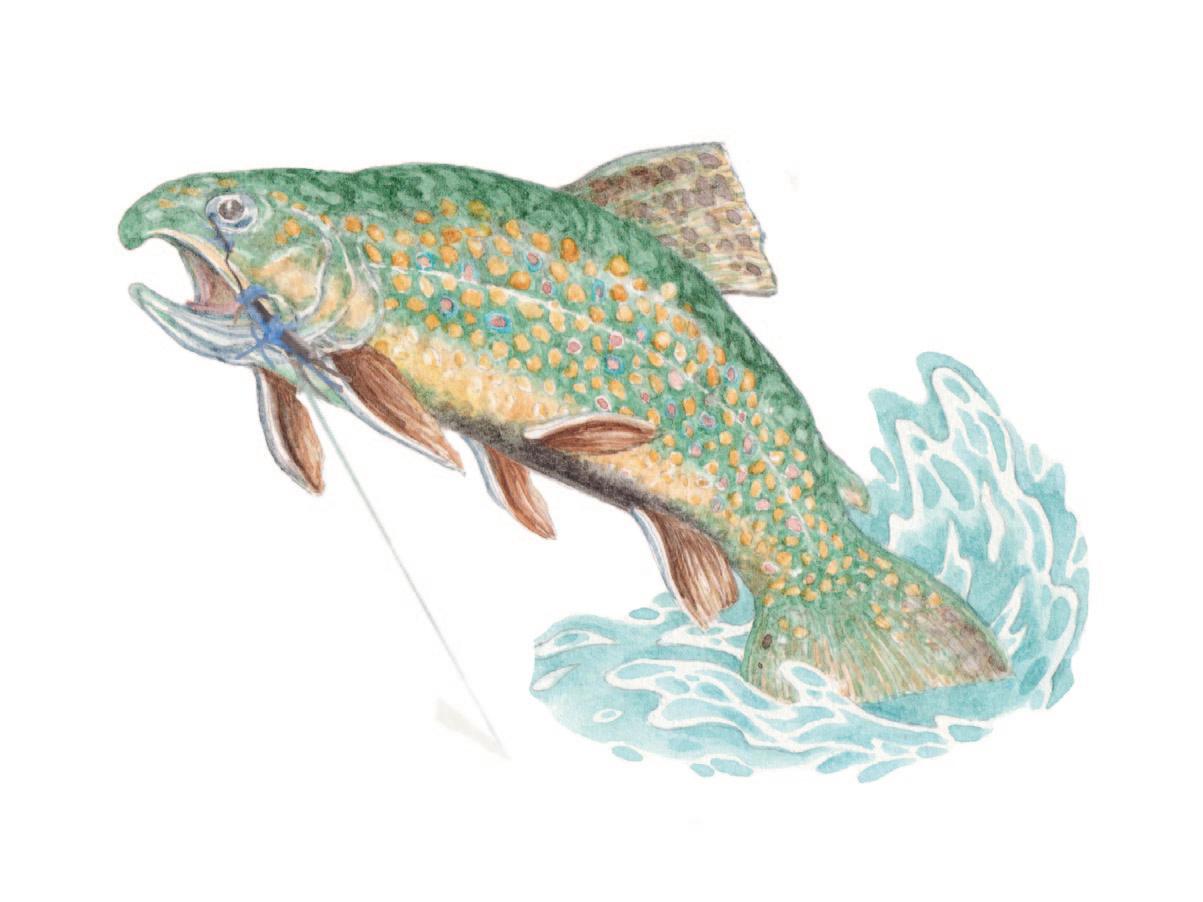
A few casts later, another trout took the fly and raced off, taking line from my reel as it headed to the pond bottom. At first I thought the leader was wrapped around a submerged snag. But eventually I was able to bring to my feet a trout twice the size of my earlier catch. A few more casts produced several additional 8- to 10-inchers, and I realized I had underestimated this pond’s potential.
I revised my inquiry to: “What would happen if I tossed a hopper imitation out there?” I tied on a purple Chubby Chernobyl and cast it out onto the pond. Upon landing, it detonated an instant explosion. The attacking trout catapulted skyward. I recall seeing the perfect silhouette of the fish against the pond surface. My motion to set the hook was entirely unnecessary because,
I spent three hours wrestling in brookies like that, filling a plastic freezer bag with trout for a fish fry but releasing most unharmed to face the otters I assumed lived nearby. That’s another joy of brook trout: In Montana, populations tend to suffer from underfishing, which causes stunting due to too many fish and not enough food. So brookie creel limits here are often generous.
I hiked home giddy, not just from the fishing itself but from the surprise of it, the joy of discovery, of having a hunch exceed my wildest expectations.
Don’t expect to see my beaver pond geotagged or featured on Facebook. It’s not that I’m too stingy to share. I just wouldn’t want to deprive anyone else of an opportunity to make their own discovery.
As is my tradition, I ate my sandwich and eyed bubbles on the surface. Maybe it was swamp gas escaping the bottom. Or maybe supping fish.
There’s no question that large carnivores are thriving in Montana. The Treasure State is home to roughly 15,000 black bears, 4,000 mountain lions, 1,500 grizzly bears, and 1,000 wolves. Whether that’s too many or too few, however, is a question argued in cafes and bars across the state.
Montana residents have mixed feelings about living and working in what could be dubbed Big Carnivore Country. Lions and grizzly bears can pose a threat to human safety. Wolves, lions, and grizzlies prey on game animals like deer and elk, and they sometimes kill livestock. Yet for many Montanans, large carnivores represent the untamed spirit of a state whose official mammal is the grizzly and whose wildlife agency has the bear’s head as its logo. Large carnivores also indicate healthy ecosystems that support abundant wildlife and provide scenic, wild areas to hike, camp, hunt, and fish.
Other than grizzly bears, Montana can’t claim to have the most of each species in the Lower 48. Roughly 30,000 black bears reside in California, Oregon has 6,000 mountain lions, and 2,700 wolves live in Minnesota. But no state south of the Canadian border has such healthy populations of all four major predators.
Part of Montana’s carnivore conservation success comes from its massive geographic size (150,000 square miles) and relatively sparse human population (1.1 million residents). Intact ecosystems not laced with housing and fences support the deer, elk, and bighorn sheep that sustain carnivore populations. And the state’s relatively few roads allow predators to move about more freely without being hit by vehicles or
illegally shot by poachers.
Much credit also goes to Montana residents who tolerate the presence of bears, lions, and wolves as long as their safety and businesses aren’t threatened. If they didn’t, the state would have far fewer large carnivores than it does.
As Montana takes significant steps forward to gain management authority over grizzly bears—federally protected for most of the past five decades—state wildlife officials are pointing to their successful track record with other large carnivores as proof that the Great Bear will be in good hands.
Officials with Montana Fish, Wildlife & Parks say the agency is internationally recognized for its mountain lion, black bear, and gray wolf stewardship, which includes regulated hunting seasons.
By Tom Dickson“We’ve proved we can sustain healthy populations of other large carnivores over the past half-century, and we’re committed to doing the same with grizzlies as we safeguard people’s lives and livelihoods,” says Ken McDonald, head of FWP’s Wildlife Division.
When Congress passed the Endangered Species Act (ESA) in 1973, lawmakers intended it to protect and recover imperiled species and the critical habitats where they live. But they did not foresee imposing federal protections forever. “The law’s ultimate goal is to ‘recover’ species so they no longer need protection under the ESA,” according to the U.S. Fish & Wildlife Service’s (USFWS) website.
McDonald argues that it’s good for all wildlife to remove a species from the endangered or threatened species list once its population recovers, as the USFWS did with the peregrine falcon and bald eagle. “The ESA is already under attack by many members of Congress,” McDonald says. “Every year that recovered grizzly populations stay on the list just gives them more ammo to claim the ESA is broken and try to overturn the law. It also weakens local support and cooperation for listing other species.”
Twice in recent years (2007 and 2017), the USFWS delisted the Greater Yellowstone Ecosystem (GYE) grizzly population in and around Yellowstone National Park. But bearadvocacy groups successfully sued to reverse those decisions, and federal courts put the grizzly back on the list of federally threatened species. The Northern Continental Divide Ecosystem (NCDE) grizzly population, meanwhile, has exceeded federal recovery criteria


for the past two decades.
On this, the ESA’s 50th anniversary, the USFWS is considering delisting the GYE and NCDE grizzly bears. In February 2023, the agency announced it was reviewing Montana’s, Wyoming’s, and Idaho’s regulatory safeguards to determine if they are adequate to merit removing federal protections from the two grizzly populations.
Under the ESA, the federal government can’t relinquish management oversight unless states show they have solid safeguards. That’s why the USFWS has set strict conditions for Montana to gain management authority over the NCDE population and its share of the GYE population.
One, the habitat must be healthy and abundant, and be protected so it will remain so. “That’s definitely true,” McDonald says. The 13,000-square-mile NCDE has more intact grizzly bear habitat—including four protected wilderness areas—than any other state in the Lower 48, and the 35,000square-mile GYE is one of the world’s largest remaining intact temperate zone ecosystems.
Two, the grizzly populations must be maintained at or above a viable size and be well distributed within the ecosystem. That standard has also been met. McDonald says studies by the U.S. Geological Survey and FWP show that the NCDE population is robust and growing steadily at a healthy 2.3 percent each year, more than doubling in the past two decades to roughly 1,200 bears. “The population is also connected to Canadian grizzlies to the north, which increases genetic connectivity and health,” he adds.
The GYE population reached the initial federal recovery goal of 500 in the early 2000s and today is estimated at roughly 1,100 bears.
Three, the USFWS insists that Montana continue reducing conflicts to help keep humans safe and bear populations healthy. FWP has met this condition in large part with department bear management specialists who work with landowners, town residents, and community leaders. FWP hired its first bear specialist in 1984, and as grizzly
populations have grown and expanded, the agency has added others in areas between core populations where bears are spreading. “This has been a huge and growing commitment by our department to get staff on the ground to help reduce conflicts and the need to lethally remove bears,” McDonald says. Bear specialists now work out of Kalispell, Libby, Missoula, Anaconda, Hamilton, Choteau, Conrad, Bozeman, and Red Lodge.
Based in Kalispell on the western edge of the NCDE, bear management specialist Justine Vallieres helps residents and communities keep garbage, pet food, and other tasty (to a bear) attractants inside secure containers or buildings or behind electric fences. She also helps landowners erect fencing around orchards, beehives, chicken coops, and calving grounds.
Sometimes she and other bear manage-
ment specialists have to relocate a bear elsewhere or, with a particularly troublesome grizzly, euthanize it. “But relocating or euthanizing a bear is just a temporary solution that doesn’t address the root cause of the problem of people leaving out unsecured attractants accessible to bears that become food conditioned,” Vallieres says.

Neil Anderson, regional wildlife supervisor in Kalispell, says the specialists have been essential to grizzly recovery. “When we can help resolve conflicts and show that people can stay safe and live their lives, we build trust in our agency and a tolerance of bears,” he says. “Those people may still not like bears, but they see that we are doing all we can to reduce the problems they are having.”
In addition, FWP bear management specialists work with more than a dozen nonprofit groups to reduce bear conflicts. The Big Hole Watershed Committee, for instance, employs a range rider to keep bears away from cattle and operates a livestock carcass collection station. The Flathead Valley–based Great Bear Foundation organizes volunteers to pick up fallen plums, cherries, and apples that attract bears to orchards and residential areas.
Another major ESA delisting condition is that states establish “adequate regulatory mechanisms” (state laws and regulations) that replace federal oversight and ensure grizzly populations remain healthy, connected, and above levels that would trigger relisting. To that end, the 2023 Montana Legislature passed SB 295, which would take effect upon grizzly bear delisting. Among other things, the legislation requires the Montana Fish and Wildlife Commission to adopt “administrative rules” outlining guidelines for when bears can and can’t be killed.
The new Montana law also dictates that the number of bears killed for any reason can’t exceed mortality thresholds outlined by the Statewide Grizzly Bear Management Plan, which will direct state grizzly bear management. The thresholds take into account the health of grizzly populations and their habitats. As it develops regulations this summer, the commission will set quotas for how many bears may be killed each year by livestock owners protecting their animals.
“This has been a huge and growing commitment by our department to get staff on the ground to help reduce conflicts.”DIGITAL ILLUSTRATION AND COMPOSITES BY LUKE DURAN/ MONTANA OUTDOORS Tom Dickson is the Montana Outdoors editor.
“The quotas will ensure that only a small percentage of the population could be lethally removed annually, so that we can safeguard the grizzly’s recovery,” McDonald says. “At the same time, the legislation gives livestock producers assurances that they can protect their livestock, up to a point, while also emphasizing the effectiveness of non-lethal protections.”
For the most part, wildlife officials maintain, state grizzly management would continue as it has under federal authority. McDonald says Montana is committed to sustaining grizzly bear recovery in the NCDE and GYE. Montana is cooperating with Idaho and Wyoming to ensure that management in the GYE is coordinated and that combined mortalities remain below limits that the three

states jointly agree will ensure healthy grizzly populations. Furthermore, the new Montana law states that, whether the species is delisted or not, Montana will increase its efforts to find new ways for
bears from recovered populations to mingle and reproduce. The state will also continue supporting populations in the Cabinet-Yaak and Bitterroot recovery areas.
McDonald notes that FWP is hiring two new specialists this summer to trap, in the NCDE and surrounding areas, grizzlies that have no history of conflict and relocate them to suitable sites in the GYE. “The goal is to ensure genetic mixing and continued genetic health,” he says.
The greatest controversy over possible delisting concerns the killing of grizzlies. Some Montanans want to see more of it; others demand no lethal removal whatsoever.
Killing some bears has always been an unfortunate but necessary part of grizzly management and recovery, says Greg Lemon,
“The quotas will ensure that only a small percentage of the population could be lethally removed annually so that we can safeguard the grizzly’s recovery.”GLACIER NATIONAL PARK YELLOWSTONE NATIONAL PARK
head of FWP public affairs. He notes that over the past decade, the USFWS has okayed the lethal removal of roughly 14 “nuisance” grizzlies in Montana each year. In most cases, state or federal specialists have trapped and euthanized troublesome bears to protect people or livestock, such as when a grizzly has repeatedly broken into cabins or attacked sheep, then returned after being relocated. “In each instance, the USFWS has signed off when lethal removal was necessary,” Lemon says. Meanwhile, grizzly bear populations have grown beyond recovery goals in both the NCDE and GYE.
In most cases, bear management specialists trap problem bears and relocate them elsewhere. But prime grizzly habitat far from where people live and raise livestock is already full. As more and more people move to the Montana countryside, relocation sites are increasingly hard to find.
Under current federal law it is legal to kill a grizzly in self-defense, but not to protect livestock being attacked. Under state management, a bear may be killed if it is “in the act of attacking or killing” livestock, and neither the USFWS nor FWP will need to approve a rancher killing a bear in that scenario—unless that year’s mortality quota has been reached. But state wildlife officials would need to authorize lethal removal before anyone killed a bear that was threatening livestock or if they believed a bear was threatening their or their family’s safety (as opposed to actually attacking).
“The administrative rules and the new legislation outline the circumstances under which lethal removal can and can’t take place for delisted grizzly bears,” Lemon says. “They provide certainty for the federal government, as well as for Montanans living with delisted bears, no matter where they reside in grizzly country, about what will happen when Montana takes on management responsibilities.”
McDonald adds that securing mortality
safeguards in state regulations is a major step in reassuring the USFWS and federal courts once grizzlies are delisted. “Putting laws into place for delisted bears is the ultimate commitment by state government,” he says. “It strongly signals how seriously Montana takes its responsibility to maintain grizzly recovery.”

As for an eventual grizzly hunting season, McDonald says it would not occur unless FWP was certain state management was conserving the bear populations and maintaining healthy genetic connectivity while adequately responding to livestock conflicts. “Even if hunting is reinstated down the road,” McDonald says, “the harvest quota would be
small—likely just a few bears per year—and would be restricted any time other mortalities, such as a need to lethally remove bears threatening livestock, increased.”
McDonald notes that all human-related grizzly mortality will continue to be carefully tracked, as it is now, to ensure the health of bear populations. “Allowing mortality for the purpose of hunting would be a lower priority after first addressing human health risks, threats to livestock, and property damage.”
Even with such assurances, not everyone is on board to delist. As with previous USFWS attempts, bear-advocacy groups and individuals have expressed skepticism that state management would sustain healthy, stable populations in the Greater Yellowstone and Northern Continental Divide ecosystems.
Dustin Temple, FWP director, says he appreciates opponents’ concerns but points to the state’s new grizzly management plan, interagency conservation strategies, additional bear specialists, strong track record managing other large carnivores, and new
1982: USFWS establishes Grizzly Bear Recovery Plan.
1975: Grizzlies are listed as a threatened species in Lower 48 under the Endangered Species Act. Management authority transferred from states to USFWS for recovery.
1975: Estimated size of GYE population: 136. Estimated size of NCDE population: fewer than 200.
1973: Congress passes Endangered Species Act

1970: Yellowstone National Park installs bearproof trash containers and bans visitors from feeding bears.
1967: On the same day, two hikers are killed in Glacier National Park in separate incidents, marking the park’s first fatal grizzly maulings.
1959: At the request of YNP, scientists Frank and John Craighead begin a 12-year study of grizzly bears. Their research shows that garbage has become the most important food for Yellowstone grizzlies.
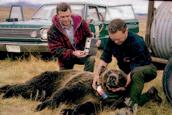
1940s: Garbage dumps in Yellowstone remain open, but all public viewing areas are closed, and sanctioned bear feeding ends.
1930s: Beginning in 1890, visitors to Yellowstone National Park are entertained with nightly “bear shows” at garbage dumps. By the 1930s, more than 250 grizzlies feed at the dumps each day.

1840-1920: Grizzly numbers begin a rapid decline. Causes include habitat loss due to homesteading and railroad construction, predator control, and the unregulated overharvest of bison, elk, and other grizzly prey.

1930s
1940s
1950s
1970s
1920s
1960s
1950s: Montana Fish and Game continues grizzly bear survey projects.
1942: Montana Fish and Game adopts a grizzly bear image for its agency logo.
1941: The Montana Department of Fish and Game conducts its first grizzly bear survey.

1930s: Grizzly bears, mostly viewed as nuisances or vermin, are reduced to less than 2% of their historic range in the contiguous United States. Most of this remaining range is in and around Glacier and Yellowstone national parks.
1923: Montana declares the grizzly bear a state game animal protected with hunting seasons and limits, the first state to do so.
1921: Montana bans the use of bait or dogs for grizzly hunting.
“We’ll keep doing all the things we’ve done to recover grizzlies to make sure they stay recovered.”
2023: USFWS announces that it’s again considering removing NCDE and GYE populations from the threatened species list.
2022: Estimated size of NCDE population: 1,200.
2022: Estimated size of GYE population: 1,100.
2018: USFWS declares NCDE population recovered but decides not to delist due to federal court ruling on GYE population earlier that year.
2018: Federal court puts GYE grizzlies back on endangered species list.
2017: USFWS delists GYE grizzlies for a second time.
2017: GYE population reaches 700 bears, 40% above recovery goal.
2011: More than 800 grizzlies are estimated to live in the NCDE.

2010: USFWS appeals relisting, maintaining that GYE bears are recovered.

2009: Federal court puts GYE grizzlies back on endangered species list.
2007: USFWS delists grizzlies in GYE.
2006: USFWS revises Grizzly Bear Recovery Plan.

2004: U.S. Geological Survey estimates NCDE population at 673 bears, exceeding recovery goal of 500.

2003: GYE population reaches recovery goal of 500 bears.
1993: USFWS updates the Grizzly Bear Recovery Plan, outlining population objectives for six recovery areas, four in Montana.

2023: Fish and Wildlife Commission will adopt state regulations limiting grizzly mortality quotas to sustainable levels.
2023: Legislature passes SB 295, instituting state regulatory mechanisms that safeguard grizzly populations and replace federal oversight.
2022: FWP produces draft Statewide Grizzly Bear Management Plan.
2022: FWP hires bear management specialist in Red Lodge.
2021: FWP hires bear management specialist in Butte/Anaconda.
2021: FWP hires bear management specialist in Hamilton.
2020: FWP hires bear education coordinator in Helena.
2019: Montana surveys residents on attitudes toward grizzly bears.
2019: Montana creates Grizzly Bear Conservation and Management Advisory Council consisting of Montana residents to advise on management policy.
2018: Fish and Wildlife Commission adopts state rule saying Montana will manage for a total population of at least 1,000 bears in the NCDE.
2017: FWP hires bear management specialist in Conrad.
2014: After U.S. Geological Survey study in 2004 shows NCDE populaton at 765 bears, FWP completes 10-year survey showing population growing at 2.3% annually.
2013: FWP produces Southwestern Montana Grizzly Bear Management Plan.
2007: FWP hires bear management specialist in Libby.
2006: Montana produces Western Montana Grizzly Bear Management Plan.
2003: GYE recovery goals met for the sixth year in a row.
2001: FWP hires bear management specialist in Missoula.
1996: FWP hires bear management specialist in Kalispell.
1993: FWP hires bear management specialist in Bozeman.
1992: USFWS ends Montana’s ability to hunt grizzlies, citing lack of evidence that harvest is not harming the NCDE population.
1991: FWP Commission omits grizzly bear hunting season from biennial regulations for 1992–1993.
1984: FWP hires bear management specialist in Choteau.
1983: Montana Legislature designates the grizzly bear as Montana’s official state animal.
1983: Montana joins newly formed Interagency Grizzly Bear Committee to help coordinate federal, state, and tribal interests to recover grizzlies.
1970s: Major research is conducted in the 1970s with the Border Grizzly Bear Study led by Chuck Jonkel, and the East Front Grizzly Bear Study led by Keith Aune. These were followed by the South Fork of the Flathead River Study under Rick Mace and a study in the Mission Mountains by Chris Servheen.
legislation as proof that Montana can be trusted. “We’ll keep doing everything that we’ve done over the years to recover grizzlies to make sure they stay recovered,” he says.
Perhaps the most important safeguard is the ESA itself. If Montana were to fail in its commitment to grizzly bears and drive populations too low, or allow dangerous threats to grizzlies or their habitat, the USFWS could relist the species. If that ever happened, Montana would lose its credibility with the federal wildlife agency and the American people. When Congress passed the ESA, it didn’t intend endless federal oversight over recovered species. But it made sure that any state hoping to regain management authority over a listed species would have to not just promise but actually prove it deserves that responsibility.

 BY JULIE LUE
BY JULIE LUE
hile walking downhill toward my trail camera, weaving my way around clumps of bluebunch wheatgrass, I try to lower my expectations. The device is trained on an old fox den at the forest edge, where ponderosa pines have overtaken the dry meadow. The burrow looks weedy and abandoned. The last time I checked my camera’s SD card, I found over 700 images of squirrels and blowing branches.
But I hear things at night from my nearby house. Sometimes when exploring the surrounding hillside, I find the tracks or scat of many wildlife species, some of which I struggle to identify. And it seems that even when it’s not occupied, the burrow serves as a stopping place for animals. White-tailed deer and raccoons pause to sniff the news, foxes and coyotes mark their territory, and owls descend from above to snag careless rodents. As usual, I find hundreds of daytime photos of a red squirrel caching pinecones. But the handful of nighttime pics are what grab my attention. Some reveal just parts of a critter: a furry, triangular ear; the antlers of a whitetail buck; the huge, fluffy tail and delicate, black-edged hind legs of a red fox. One shot shows a coyote with its muscles bunched, ready to pounce, eyes glowing in the camera’s LED.
Nothing too surprising this time, but I still appreciate the tiny, blurry window my trail camera has given me into the nighttime world of animals. Vignettes like these have helped spark my interest in learning more about what wildlife are up to when the lights go out— whether they’re fast asleep, making a racket, or moving silently, unnoticed, through the darkness. uu
Like us, most birds and squirrels are diurnal, or active during the day. Other wildlife, such as deer and beavers, are mostly crepuscular, active primarily at twilight (early morning and late evening). Still others, like skunks and porcupines, are mainly nocturnal, out and about after the sun goes down. But very few species fit neatly into just one category. The activity patterns of animals can be influenced by weather, season, competition, food, offspring, and the presence of humans.
“There’s no hard and fast rule,” says Torrey Ritter, Montana Fish, Wildlife & Parks regional nongame wildlife biologist in Missoula. “I’ve even seen bats flying over Lake Como during the middle of the day.”
In late evening, the active periods for many species overlap, providing a chance to see diurnal, crepuscular, and sometimes even nocturnal species at the same time (one reason wildlife watchers are often most successful just as the sun goes down). “This ‘power hour’ period—the hour before and after sunset—is when you’ll see a ton of activity,” Ritter says, “whether it’s fish chasing other fish in the shallows, or hawks, coyotes, and foxes pursuing their prey.”
As the light fades, daytime-adapted species need to find warmth and safety. Small birds, for instance, seek out floodplain junipers, clumps of mistletoe, or other thick growth in trees and shrubs for both thermal cover and concealment. “They pile into places like these, which are so dense a hawk or owl can’t get in there,” Ritter says. Birds don’t sleep on their nests unless they have eggs or young, but many will use tree cavities for a nighttime roost. Tree squirrels also use cavities or take refuge in leafy or twiggy nests called dreys. Ground squirrels and marmots sleep underground.
After sunset, hawks and ospreys head for the treetops, taking advantage of a special talent shared with most other birds: They can sleep, perched, without falling over. If a bird’s legs remain bent, its Achilles tendons keep its toes and claws tightly curled around a tree branch. When the legs straighten, the toes release.
Some birds also have the ability to let half their brain sleep at a time—in what’s called unihemispheric slow-wave sleep—while keeping one eye open and maintaining
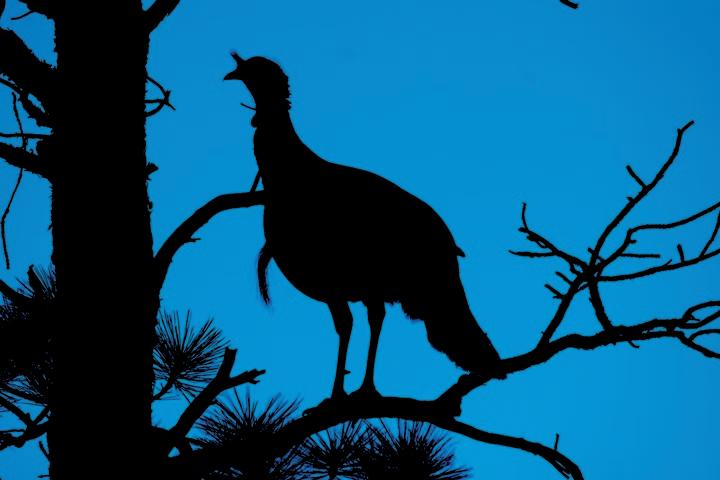
enough alertness to fly, rest on the water, or keep watch. At night, hummingbirds can enter a state of torpor, like a mini hibernation, in which their body temperature decreases to save energy.
As the sun dips below the horizon in summer, nighthawks wheel through the sky, calling and booming. From their low perches in open country, common poorwills—relatives of the whip-poor-wills found in states to the east of Montana—whistle mournfully, poorwillip, and flutter up to snatch bugs from the air.

On rivers, myotis bats swoop down to take a drink, and fish start to move into the shallows, relatively safe from aerial predators once ospreys and bald eagles retreat for the day.
Cooler evening temperatures provide a respite from summer heat for large, furry mammals like elk and bears, and small, easily dehydrated amphibians like western toads, which scramble out of their shaded daytime hideouts to patrol for bugs. Growing darkness brings out a banquet of prey species, including mice, voles, and moths and other insects. Short-eared owls hunt over open country. Deer are on the move,
A northern flying squirrel leaps from tree to tree on a late winter night near Seeley Lake. Flying squirrels are nocturnal and especially active during their latewinter mating season.
constantly alert to the threat of mountain lions, wolves, coyotes, and bears.
Just as they do during the day, animals spend the twilight and nighttime hours going about their business: finding food and mates, caring for their young, defending their territory, seeking shelter. But they need the ability to navigate their surroundings in dimmer light.
Most animals active after hours have better night vision than we do. Some have especially large eyes, with a higher proportion of photoreceptor cells called rods, which sense light, and a lower proportion of cone cells, which allow for color vision. Many species also have a special membrane at the back of the eye called a tapetum lucidum. Latin for “bright tapestry,” this film reflects light back through the retina, producing better night vision, as well as the “eyeshine” we see reflected back from our headlamps or vehicle headlights at night.
Wildlife also depend heavily on their other senses. Rabbits and hares don’t have a tapetum lucidum, but like many other creatures active at twilight, they use their keen hearing
and senses of smell and touch to help them navigate. Sensitive whiskers—like those on rabbits, hares, dogs, cats, deer, and many other species—help guide animals around or through nearby objects they can’t see. Even bats have whiskers, which supplement their vision and sonarlike echolocation, allowing
SNAKES ALIVE Garter snakes and other reptiles often become nocturnal in summer. Because cold-blooded animals can’t regulate their body temperature, they may overheat and die during hot summer days.

them to locate prey in total darkness. All fish can sense movement in the water with the lateral line organ along each side of their body. The channel catfish’s whiskerlike barbels and the burbot’s single chin barbel are covered in taste buds, allowing those fish to find food in darkness or in murky water.
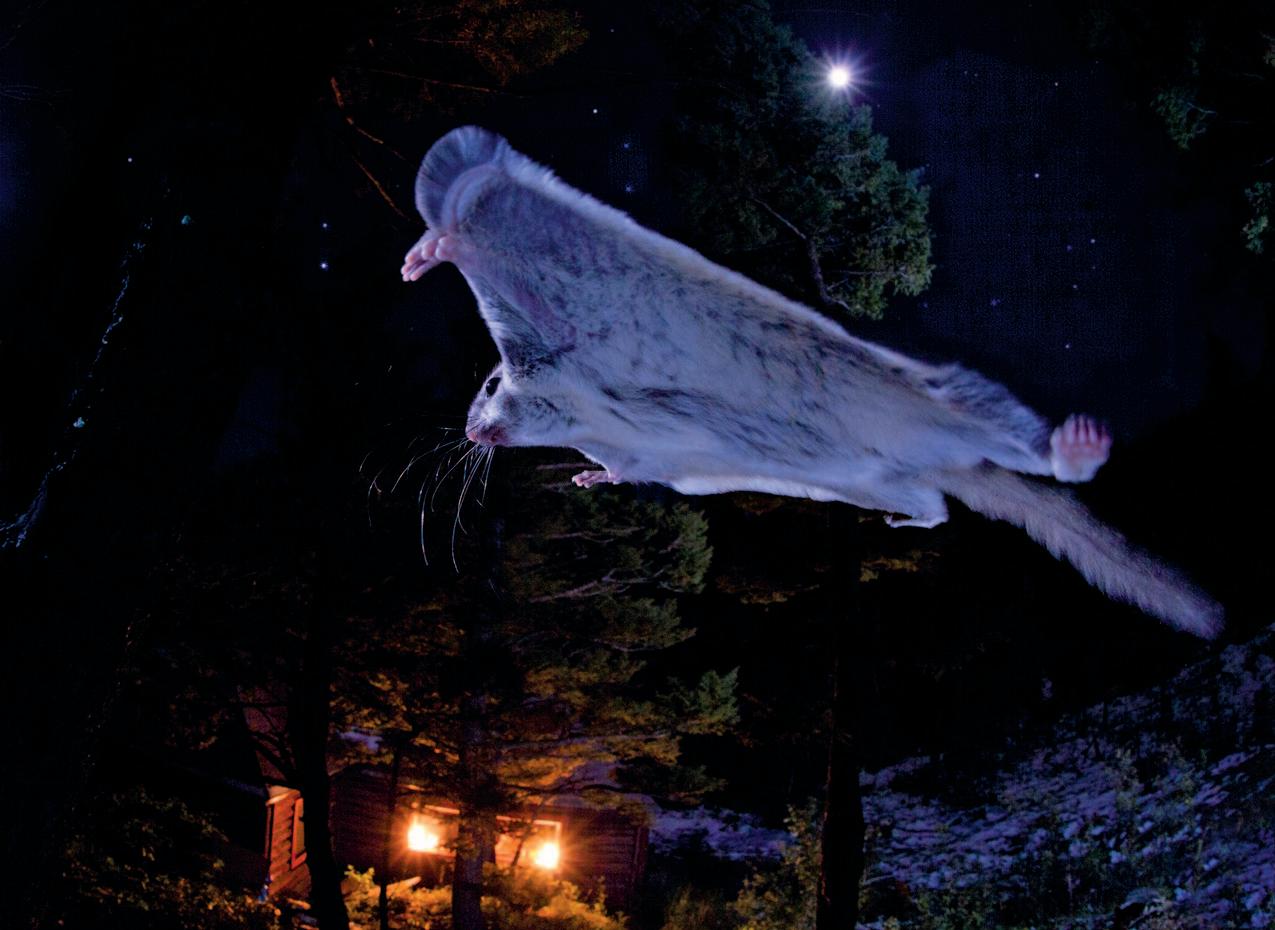
All living creatures need sleep, but sleep blunts the senses. Wildlife use many different strategies to meet their sleep needs while staying safe. Many animals are light sleepers or nappers, even “micro-nappers.” For instance, to make up for lost nighttime sleep during spring and fall migration, Swainson’s thrushes will periodically grab 10 seconds of sleep during the day.
Total sleep needs vary widely. Large predators, and animals like ground squirrels and bats that can retreat to safe shelter, tend to sleep more. Little brown bats can log 19 hours at a time.
Because they must remain alert for predators, hoofed mammals tend to sleep less. Deer clock about 4.5 hours of sleep in a 24hour period. But they can’t just bed down and sleep in one block. “Their daily and nightly life consists of cycles of feeding, ruminating, and sleeping,” says Rebecca Mowry, an FWP wildlife biologist in Hamilton. Like other ruminants—including elk, moose, bighorn sheep, mountain goats, pronghorn, and bison—deer need to spend a lot of time eating and processing their food. After quickly filling up on grass or browse, they return to the dense forest or another safe place to regurgitate the vegetation and chew it again, converting the plant matter into a more digestible form, a process known as “rumination” or “chewing their cud.” Often when deer are bedded down, they’re not sleeping; they’re ruminating.
Deer are also trying to avoid being eaten, which can lead to unpredictable schedules. “Their sleep patterns are highly variable depending upon food and habitat availability, prevailing weather patterns, and most importantly predation pressures,” says Dr. Kerry Foresman, emeritus professor of wildlife biology at the University of Montana and author of Mammals of Montana. As a primary food source for many predators, deer “have developed a ‘cat nap’ strategy,
or sleeping for short periods of time
always being vigilant,” Foresman says.
Deer can be easily roused at any time, which Foresman notes is “obviously a survival strategy that has evolved in deer species because of this predation pressure. And it isn’t lost even if the pressure decreases. Better to be safe than dead.”


While others sleep, some critters move about so quietly they escape our notice.
In forests, big-eyed northern flying squirrels silently glide between tall trees. In mountains, tiny, lungless Coeur d’Alene salamanders leave rock crevices near seeps and springs, or their refuges behind waterfalls, to search for insects. Over fields and through forests, owls glide without a sound, the serrated leading edge of their softly feathered wings breaking up the turbulent air that typically creates a swooshing noise as birds fly. And nearly everywhere in
Montana, mountain lions hunt.
Lions are experts at staying under the radar, according to Jim Williams, retired FWP regional director, large carnivore specialist, and the author of Path of the Puma But wherever whitetails and mule deer live, mountain lions do, too. “If you’ve got deer, you’ve got cats, whether you know it or not,” Williams says.
Mountain lions hunt mostly during lowlight periods around dusk and dawn, at the same time that deer, young bighorn sheep, elk calves, and other favored prey move about. “They’re active when their grocery

store is active,” Williams says. But the best cover for a stalk-and-ambush predator is complete darkness.
Mountain lions are visual predators. Their huge eyes and highly adjustable pupils allow them to see well at night. Quiet, secretive, and stealthy, mountain lions are a “perfect predatory machine,” Williams says. And the big cats’ ability to live their lives largely unnoticed by humans, often under cover of darkness, has allowed them to make an impressive comeback. According to Williams, “Cats are the only large carnivores on planet Earth that have reclaimed or are reclaiming
their historic habitat and distribution and range.” People generally tolerate increased lion numbers as long as they stay out of sight, he adds, but when cats show themselves with tracks in the snow or on trail cams, “that’s when FWP and other wildlife agencies start to get the frantic phone calls.”

Some animals can be on the move at any time day or night. For instance, most birds that are active during the day actually migrate at night, using Earth’s magnetic field and starlight to find their way. According to the World Migratory Bird Day website, most birds journey after dark to avoid daytime predators like hawks and falcons. Plus, cooler night air keeps them from overheating during their journey.
Unfortunately, urban and rural sprawl has greatly increased light pollution throughout the world. Studies show that artificial lighting can cause birds to become disoriented, making them more susceptible to exhaustion and collisions with power lines and buildings.
Lucky for us, scientists and dedicated birders record and identify nocturnal flight calls to help det ermine which species are migrating. And the analysis of weather
radar data allows us to “see” waves of migration as the birds sweep over the land. You can track migrations at BirdCast.info— a project of the Cornell Lab, Colorado State University, and the University of Massachusetts Amherst.
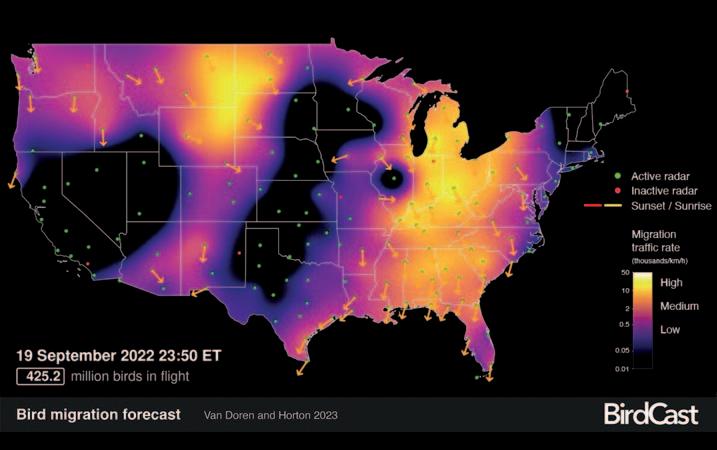
On a warm evening in mid-September, I find myself sitting in my yard after sunset. The night is quiet, and I can’t see much of
anything. But something amazing is happening overhead. When I open BirdCast on my phone, radar shows the first flickers of activity in Montana as flocks of birds begin their nocturnal flight. Hours later, migration will peak for the night with an estimated 13 million birds in flight over our state, heading south. As we sleep, the sky far above us will be filled with wings.
On March 9 of this year, I received a very unwelcome text message: One of my Painted Rocks bighorn sheep GPS collars had switched to “mortality” mode.
This wasn’t just any sheep: We’d caught him in February 2021 during a helicopter net-gunning operation, in which we netted, immobilized, then collared several bighorn rams and ewes to monitor their movements across the landscape and, when they eventually died, learn the cause. During the capture operation, we noticed that this ram had a badly broken rear leg. It wasn’t caused by the capture; his cracked tibia was scarred over and bulbous with the hoof bent backward and overgrown. He’d essentially been walking on his knuckle, for a year at least.
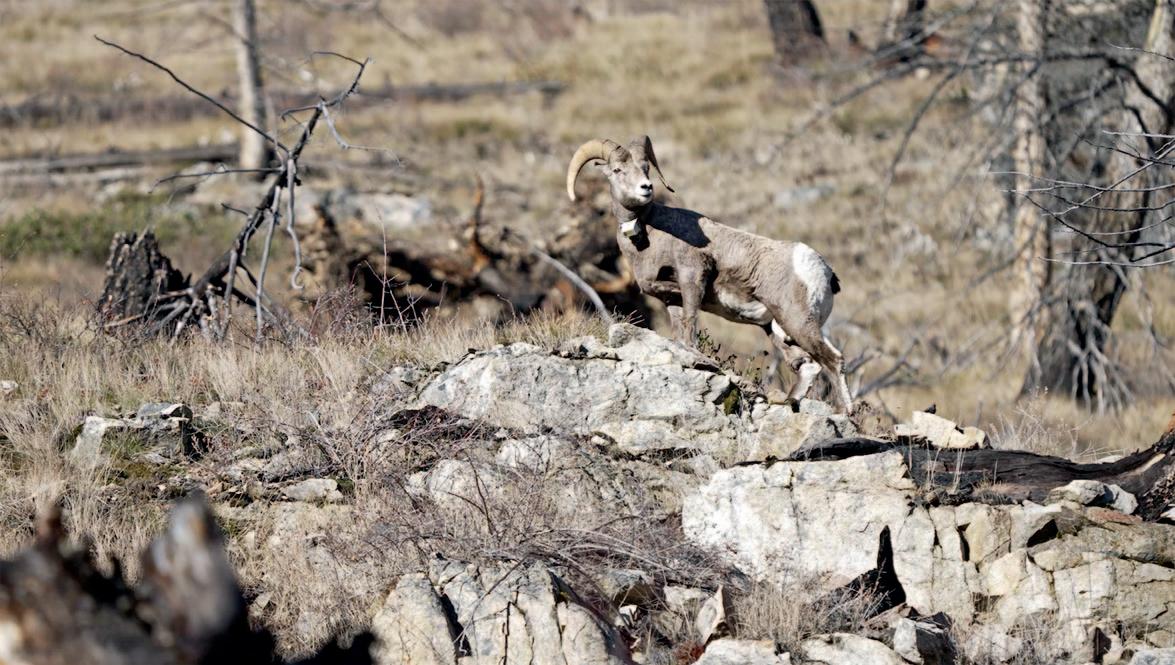
I remember the team debating whether we should euthanize him then and there. But since the injury was old, we decided to give him the benefit of the doubt, collar him, and hope for the best. He ended up being my most interesting sheep.
Probably due to the injury, the ram was small for his age, which we estimated from his horn rings was about four years at the time of capture. But even with a badly broken leg, he could sure cover ground. Each spring he traveled over 15 miles from Painted Rocks Reservoir northeast to Trapper Peak, the highest mountain in the Bitterroot Range (10,157 feet). We had no idea these sheep would
By Rebecca Mowrymove that far, or go that high. He spent all summer up there, ranging across the high country toward (and sometimes across) the Idaho border and then back to Trapper. Then, like clockwork, he’d return to Painted Rocks for the rut. He made this journey several times before his untimely demise.
Immediately after I received the mortality alert—sent by the collar after the animal is immobile for four hours—my dog and I hiked up a steep hill north of the reservoir and there, at the base of the cliffs, was the ram. We’d followed mountain lion tracks in the snow to the kill site, and it appeared likely that the ram had been killed by a lion. Wound marks indicated the carnivore had held the ram’s face to suffocate him, and his fur had been plucked off, characteristic of a lion attack. Likely his broken leg made him easier prey, and it was surprising he lived as long as he did.
I like to think that wildlife appreciate the grandeur of their habitat as much as we do. Bighorn sheep country is truly glorious. After removing the sheep’s GPS collar and preparing for the return trek, I had to sit down in the snow and take a moment. As I looked out over the wild, rugged West Fork Bitterroot River valley from those lofty cliffs, I couldn’t help but admire Broken Leg Ram and all he had accomplished in his short life. He beat the odds (at least for a time). And his existence added greatly to our understanding of his herd while providing us a glimpse of the incredible tenacity of life in some of the West’s toughest terrain.
 By Andrew McKean
By Andrew McKean
f sandhill cranes are the very song of spring for me, fall is announced by the arrival of two gallons of honey that Jim Rodenberg leaves on my porch. It’s a trade for allowing his beehives to occupy an unswathed corner of my alfalfa field.
As much as I enjoy the honey, which tastes like ripe melon and yellow raisins, and which by gloomy February here in northeastern Montana is the equivalent of bottled sunshine, I appreciate the note that accompanies this annual offering even more. In it, Rodenberg and his crew at Northern Bloom Honey, based outside Wolf Point, detail the honey season. Some years, he writes, clover and blue flax contribute mightily to the golden nectar. Other years, it’s alfalfa and
canola. Drought years are expressed in dark honey that tastes surprisingly like tea.


Over the years, I’ve squared my own observations with Rodenberg’s. In the falls when he reports prodigious honey production, I have my best hunting seasons for pheasants and sharp-tailed grouse. In the dark-honey years, I struggle to find birds.
The connection is pollinator habitat, the overgrown tangle of wildflowers, shrubs, brush, and vines at the edge of a field or fence line that’s hard to walk through and always seems to have bumblebees and orb spiders working in the pants-grabbing brambles. If you were to stand in this wild garden on a windless day, you could probably hear the buzz of insects prospecting for pollen.
Unfortunately, numbers of those insects—
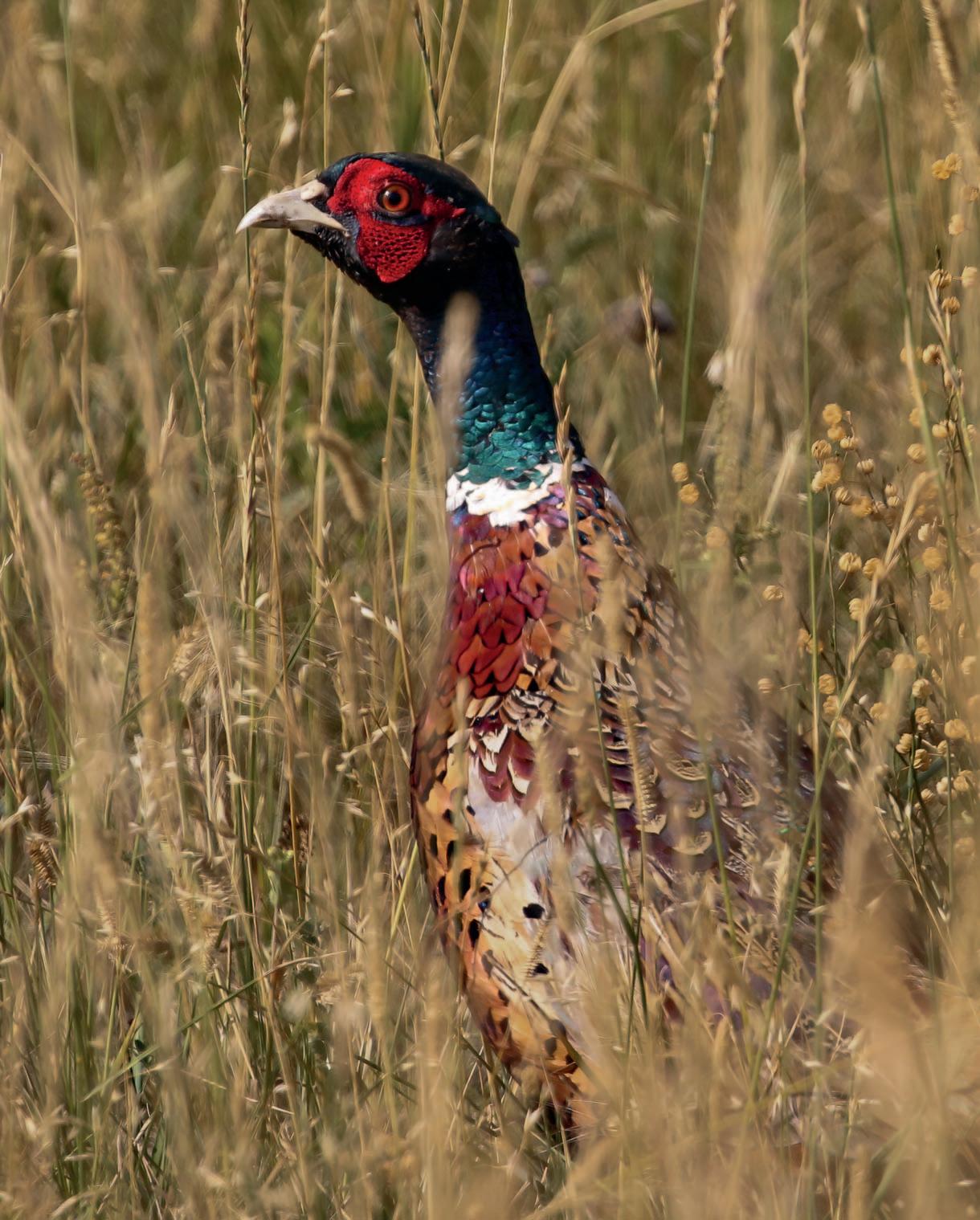
including monarch and painted lady butterflies, leafcutter moths, and tiny metallic blue mining bees—are declining. No one is certain why, but one likely reason is because there’s less pollinator habitat every year, as we clear and tame these unruly corners of our lawns and cemeteries and crop fields.
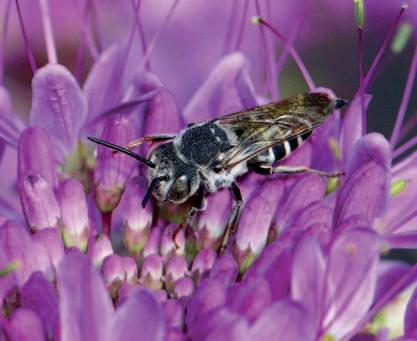
It’s a dreary fact that a half-dozen native Montana butterflies are classified as state “species of concern,” at risk of further declines and even of tumbling into federal threatened or even endangered status, due mainly to threats to the places where they live. The loss of native butterfly, bee, beetle, and moth habitat appears to be driving declines in these pollinators’ populations, says Rick Northrup, chief of the Montana Fish, Wildlife & Parks Wildlife Habitat Bureau.
The solution, Northrup adds, is the same as it is for sage-grouse, Sprague’s pipits, or other grassland birds that adapted to native landscapes and are now disappearing: “It’s critical to keep native landscapes intact. When we have the full complement of forbs and shrubs on our native prairies, flowering starts in April and continues all the way through the fall, so there’s a progression of blooms that take care of the insects, which in turn feed birds from chicks up through juveniles and adults.”
Beyond habitat loss, other threats to native pollinators include intensive use of wide-spectrum herbicides that kill plants at the heart of the pollinator-plot mosaic, and pesticides that kill many beneficial insects and leave survivors unable to fly or forage as well as before. Domestic honeybees also destabilize ecosystems, outcompete native pollinators, and carry diseases and parasitic mites that infect Montana’s native bees that adapted to the state’s native flowering plants.

Pollinator habitat can be found across Montana—from serviceberry patches in mountain foothills to floral alpine meadows that hum with buzzing bees. But the plant communities with the most loss and, paradoxically, the most recovery potential are the state’s central and eastern prairies.
“I don’t necessarily think we should be surprised to see this scale of loss of insect diversity when we’ve lost 60 to 70 percent of our native prairie in some counties,” Northrup says. “That’s why our department is focused on offering working ranches a variety of options for keeping remaining prairie habitats intact.”
Those options include traditional conservation easements, which pay willing landowners to not plow or build on prime prairie,
and FWP’s new Habitat Conservation Lease Program, which pays landowners to protect high-priority wildlife habitat, including pollinator habitat.
In the long run, says Ken Plourde, FWP’s upland game bird habitat specialist based in northeastern Montana, conserving intact landscapes—with complexity, diversity, and resiliency established over thousands of years—does more for the prairie and its wildlife than paying landowners to plant new pollinator plots on previously plowed acres.
“Conserving native prairie habitats is by far the most important thing FWP, other agencies, and landowners can do for pollinators,” says Plourde. “The great thing about conservation tools like long-term leases is that we don’t have to explicitly plan or account for every species we want to conserve, whether it’s deer or birds or insects. Just by maintaining intact landscapes we can protect everything.”
That’s not to say that previously plowed fields can’t still benefit pollinating insects. Biologists and producers are recognizing that planting a mix of native shrubs and


Conserving native prairie habitats is by far the most important thing FWP, other agencies, and landowners can do for pollinators.”
forbs (wildflowers) along edges of crop fields, in uncropped corners of center-pivot irrigation circles, or even in suburban backyards can give local bee and butterfly populations a boost. Several agencies and NGOs, including FWP, Pheasants Forever, and the Natural Resources Conservation Service, cost-share with landowners up to 75 percent of seed mixes for pollinator plantings.
These elegantly unruly plots of milkweed, thistles, cornflowers, flax, and daisies are designed to bloom in succession, the mix of annual and perennial plants providing food and cover for small game and birds even when plants aren’t flowering.
Plant diversity is essential for grassland birds, including pheasants and grouse. The grasslands that support the most flowers and broad-leafed plants are intricate, diverse, and seasonally floral.

Those adjectives describe healthy pollinator habitat, says Leslie Cooper, a cooperative biologist for Pheasants Forever. “Pollinator habitat is the little black dress of conserva-

tion,” she says. “It can really go everywhere and it’s versatile enough to do anything.”
In her habitat restorations, Cooper aims for a steady blooming of native wildflowers, flowering shrubs, and woody plants such as milkweeds and thistles from spring to late summer to meet the seasonal needs of ground-nesting birds. “When we’re planting or improving a pollinator plot, we’re trying to mimic what historically occurred on the landscape, which is a high diversity of native forbs and wildflowers that bloomed in succession throughout the growing season,” Cooper says. “Upland birds require nesting habitat, brood-rearing habitat, and escape cover, and pollinator habitat is important to all three life-cycle components.”
Cooper further notes that, unlike many stands of grass-centric Conservation Reserve Program (CRP) seedings clogged with dead plant matter, pollinator plots generally have plenty of bare ground below the blooms. “Young chicks need that open space at ground level when they’re the size of ping-pong balls to move and to feed and to escape predators. And it turns out that something like 70 percent of our native bees are solitary ground nesters, so it benefits them, as well,” says Cooper. “Later, as those chicks mature, they rely on softbodied insects for their protein, and pollinator habitat produces a massive amount of insect biomass. Still later, after they transition to seeds, pollinator habitat continues to work for them because it contains a good diversity of seed-bearing plants.”
Pollinators also benefit grain and other crop producers in places like Montana’s Golden Triangle northwest of Great Falls, the epicenter of the state’s wheat production. There, Choteau-based Erin Fairbank—until recently a biologist with Pheasants Forever and the NRCS—pitched pollinator habitat to cerealgrain farmers, recommending that producers plant pollinator mixes in the overlooked borders of section-long wheat fields or the ragged margins of derelict homesteads.
Pollinators don’t boost wheat and barley production directly, as they do alfalfa, a flowering plant. But diverse, dense pollinator plantings can trap snow and hold moisture along field edges, improve soil health,
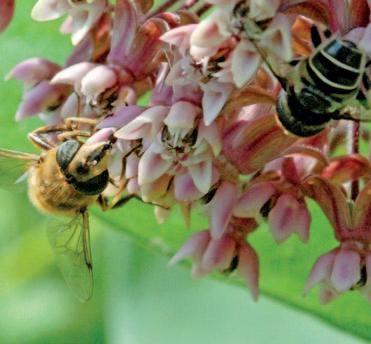

Upland birds require nesting habitat, brood-rearing habitat, and escape cover, and pollinator habitat is important to all three life-cycle components.”CLOCKWISE FROM BOTTOM LEFT: STEVE OEHLENSCHL AGER; DAN ELLISON; LISA BALLARD; SHUTTERSTOCK
and reduce wind and water erosion, Fairbank says. And pollinator plots attract beneficial insects that kill pest bugs like wheat stem sawflies.
Fairbank notes that many producers also enjoy the aesthetics of wildflower plantings and want to help upland birds and other wildlife but can’t afford the pricey pollinator s eed mixes, which run $70 to $300 an acre, plus costs to prepare the ground and plant the seed. Several federal Farm Bill programs have incentives for plantings that benefit fast-disappearing bee species and other pollinators. Fairbank negotiated cost-share agreements through local NRCS offices to make it affordable for producers to plant pollinator mixes in field borders and corners, or convert entire crop fields.
The Farm Bill provides these incentives because, without insects moving pollen from one plant to another, the United States could not grow fruits, nuts, or vegetables. Most flowering plant species require insect pollination, including the alfalfa that sustains Montana’s beef industry. In all, pollinators contribute more than $20 billion annually
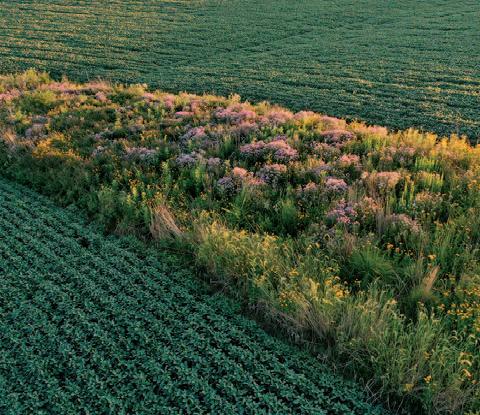
to the U.S. economy, and wild pollinators account for half of that contribution, according to recent studies. It’s no exaggeration to say that wild bees, butterflies, and moths are the invertebrate backbone of nearly all floral and fruiting plants in Montana.
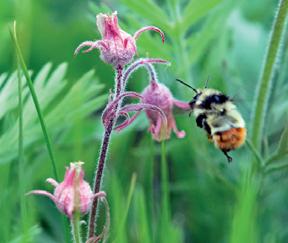
Potential federal ESA listing
The recognition that homegrown pollinators may need the sort of help that FWP,
landowners, and partner agencies have extended to sage-grouse, bull trout, and other native species experiencing population declines is a fairly new idea. “It isn’t clear if FWP even has any legal jurisdiction over insects like pollinators,” says Ken McDonald, head of FWP’s Wildlife Division. “But we recognize their importance and also the possibility that some could become federally listed.” McDonald says that two bumblebee

species and a butterfly that occur in Montana are being considered for federal Endangered Species Act listing. “So we are trying to incorporate pollinator habitat needs into our Upland Game Bird Enhancement Program. But at this point, we haven’t hired a pollinator biologist or entomologist
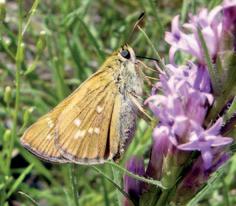
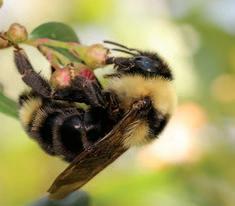
as some other states and upland conservation groups have.”
Declining numbers of insect pollinators is a nationwide problem. The three Montana pollinators that face potential Endangered Species Act listing are, clockwise from left, the Pawnee montane skipper, western bumblebee, and Suckley’s cuckoo bumblebee.
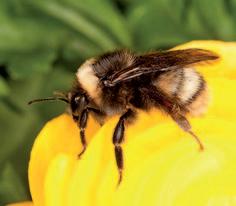
For now, FWP is doing all it can to help protect unplowed native prairie, with the goal of enrolling 500,000 acres in conservation agreements. “Our efforts and those of other agencies and conservation groups to work in partnership with ranchers and other landowners to retain vast native habitats is a direct benefit to all wildlife species—from pronghorn to sharptails to native bumblebees—that have adapted to those landscapes,” McDonald says.
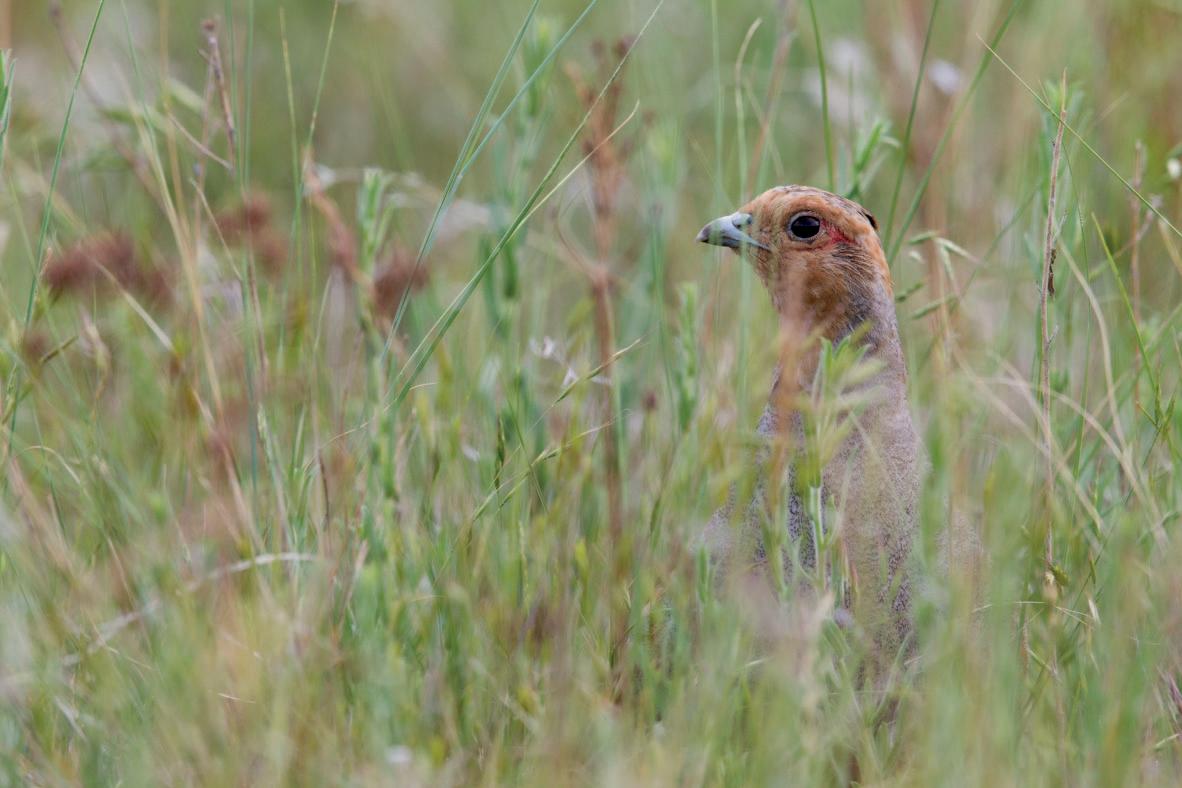
Back on Montana’s Hi-Line, beekeeper Jim Rodenberg observes a “happy bee” metric that helps him assess honey production. When his bees don’t have to travel far from their hive to collect pollen, and when the landscape is a garden of flowers both cultivated and wild, he has
bumper crops of what he calls his “liquid gold.” But Rodenberg is also a bird hunter, and he has his best days on wild roosters in the very same fields where his bees thrive.
“It’s the bloom,” says Rodenberg. “The bees are looking for it. The insects like it, and the birds follow because it provides everything they need. If you take care of the bloom, then everything else sort of takes care of itself.”
If you take care of the bloom, then everything else sort of takes care of itself.HEALTHY HOME A gray (Hungarian) partridge finds plenty of food and cover in a diverse pollinator plot. Increasing numbers of crop growers across Montana are learning that they can boost grain production while helping wildlife and adding to local beauty with these subsidized plantings.
Will kayaking someday overtake fishing as Montana’s favorite water-based recreation? According to the Outdoor Foundation’s 2021 Outdoor Participation Report, recreational kayaking—which is different from whitewater kayaking, which requires a helmet and advanced skill—is the nation’s fastest-growing water sport, with a 32 percent increase from 2015 to 2020. Fishing participation grew by roughly 15 percent during that time.
What’s kayaking’s appeal? Much the same as with fishing: enjoying nature, beautiful scenery, and time outdoors with friends and family. What’s more, recreational kayaking is relatively inexpensive. It’s also easy to learn, and the craft can be hauled without a trailer. No backing down a boat ramp lined with judgmental onlookers shouting steering advice.
I’ve watched the rise of recreational kayaking on the blue-ribbon stretch of the Missouri over the past 22 years, and my
observations square with the participation data. In the first several years I saw few casual floaters on the river, mostly sunburned partyers in innertubes. Then about 10 years ago, manufacturers found ways to make molded plastic kayaks affordable for an entire family. Today a person can buy one at Walmart for under $250, while some inflatable kayaks sell online for less than $150. You can even pick one up at some grocery stores when you go in to buy a gallon of milk.
As with so many outdoor activities, recreational kayaking took off during the COVID pandemic. People wanted to play outdoors, especially on Montana’s scenic rivers. Graband-go kayak packages were tailor-made to fill the need.
As the boom in kayaking (and associated stand-up paddleboarding) made it easier for more Montanans and visitors to enjoy the outdoors, it also created problems. Fly anglers, especially, gripe about kayakers for:
not caring where anglers are casting, and then floating too close to rising fish;
being too loud, with their rowdy laughter and Bluetooth speakers blaring music, which doesn’t sit well with those seeking a quiet time on the river; and
not understanding longstanding boat ramp etiquette required so that lines of trailered boats can efficiently get on and off the ramp. (Tip to kayakers: Move your kayak and other gear off the ramp as quickly as possible so others can use it.)
Anglers’ biggest complaint is that, unless kayakers buy a fishing license, they don’t contribute a dime toward buying and maintaining FWP fishing access sites. No, state tax dollars don’t fund the areas.

Last August I figured, if you can’t beat ’em, join ’em. I left my fly gear in the vehicle and launched a kayak onto the Missouri— just me and my dog. What a day! I didn’t have to deal with my unruly mess of rod, reel, line, leader, tippet, flies, strike indicators, split shot, fly floatant, nippers, hemostat, net, and more. No need to search for rising fish or figure out at what depth trout were taking nymphs. Mesa and I just drifted with the current and enjoyed the surrounding scenery and occasional bald eagle or osprey flying overhead. So peaceful.
Sure, a few wade anglers glared at me, but I just waved and smiled. I wanted to tell them to ditch their gear and come join me. Who needs fishing? Kayaking’s where it’s at!
Then an angler’s rod bent and he was fast to a big rainbow. I watched as he carefully waded downstream to keep up with the big trout, his reel screaming each time the fish made a deep run. Finally he worked the lunker to the shallows. I drifted past as he knelt down to release what looked like a 22inch rainbow, a big grin on his face.
He looked up at me and waved. I waved back with a slightly forced smile, thinking of my fly gear sitting back in my vehicle.
Who needs fishing? Apparently I do.
It hides as a sand-colored lump, blending in with the dry soil. But as soon as the Carolina grasshopper leaps into flight, its camouflage is shattered. Lumbering through the air, the winged insect reveals its distinctive black hindwing edged with yellow. Of Montana’s 90-plus grasshopper species, this one is the easiest to identify. Along roadsides and barren areas throughout the state, it’s a characteristic part of Montana’s late summer landscape.
This is one of the largest grasshoppers in Montana. Look for a jumbo-size ’hopper as long as the end two joints of your index finger—roughly 2 inches—and only slightly less thick. Good luck spotting one on the ground, though: The Carolina grasshopper is well-concealed, with a body ranging from dark gray to sandy pink, depending on local soil color. The easiest way to identify one is when it leaps into flight. This is the only grasshopper in Montana whose hindwing is mostly black, bordered by a narrow yellow band.
The wing color is confusingly similar to that on Montana’s state butterfly, the mourning cloak (Nymphalis antiopa). But compared to the mourning cloak, the Carolina grasshopper’s flight is less floppy, and when it lands you can see that it’s not a moth.
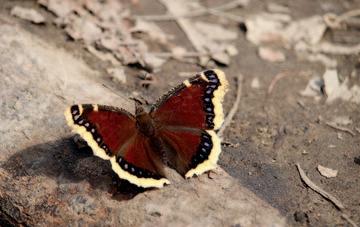
This grasshopper likes barren areas. Look for it along roadsides and railroad tracks, on dry lake beds, and around abandoned urban lots. All these habitats feature mostly bare ground with a few grasses and weeds.
Shane Sater is a writer and field naturalist in Helena who writes the Wild with nature blog and podcast.
Carolina grasshoppers have a broad and flexible diet. Depending on where they live, they can thrive on weedy plants like smooth brome and kochia, or on native grasses and broadleaved plants such as western wheatgrass and scarlet globemallow.
In late summer, male Carolina grasshoppers are busy trying to attract females, making soft crackling sounds in flight as they flash their colorful wings. The males move frequently, flying and crawling in search of a mate. They occasionally make a quiet rasping song from the ground, rubbing their hind legs against their forewings.
After mating, the female looks for a patch of bare soil in which to lay her eggs. With the tip of her abdomen, she inserts a C-shaped egg pod into the soil, burying it an inch or two deep. An egg pod contains 40 or more individual eggs.
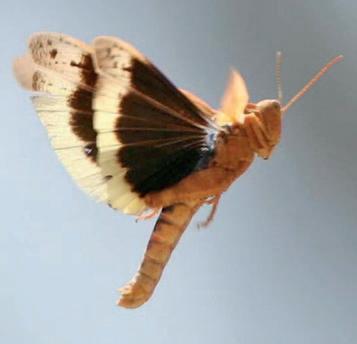
Carolina grasshoppers survive Montana’s harsh winter in the egg stage, tucked in their
underground pod. Early in the summer, the nymphs hatch. After 45 days or so of feeding, the nymphs develop into reproductively mature adults, which begin to appear in July. The adult grasshoppers survive until the first hard frosts.
In late summer, grasshoppers are consumed by a wide variety of wildlife, from meadow voles and deer mice to western meadowlarks and even Swainson’s hawks. As anglers know, trout and other surface-feeding fish will snap up grasshoppers that get windblown onto a stream or river. Spiders and some species of sphecid wasps also hunt adult grasshoppers, and the larvae of some blister beetle and bee fly species feed exclusively on grasshopper egg pods.
Like rock pigeons and white-tailed deer, the Carolina grasshopper is one of those hardy species that thrives where humans live. As long as we have places with bare soil and a few weeds, Carolina grasshoppers are likely to remain as reliable residents of Montana’s barren areas during late summer.
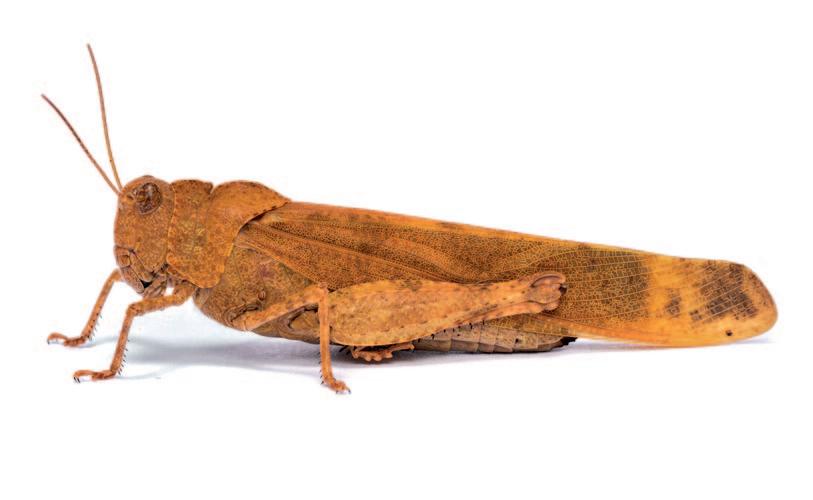
Whether it’s by boating, hiking, fishing, mountain biking, wildlife watching, or backpacking in the Absaroka-Beartooth Wilderness, Montana is a state where everyone can find their own special way to connect with the natural world. Around here, the outside is in us all.

BY
Online: fwp.mt.gov/montana-outdoors
Subscriptions: 800-678-6668

